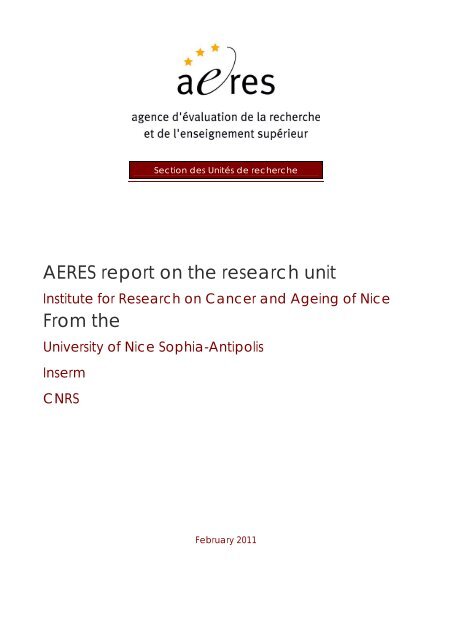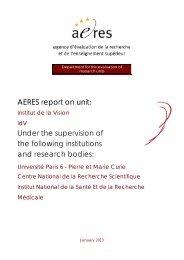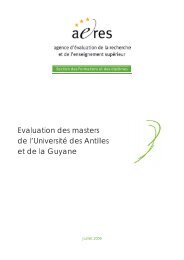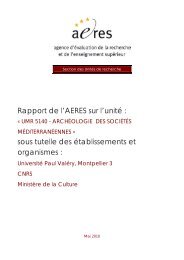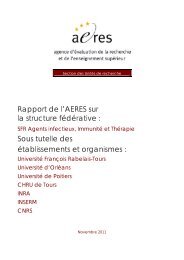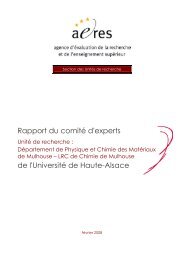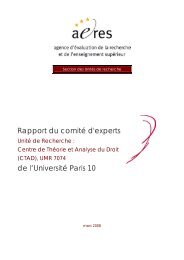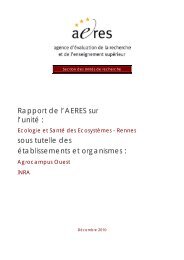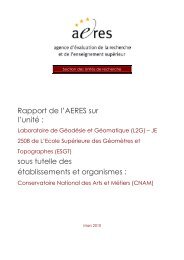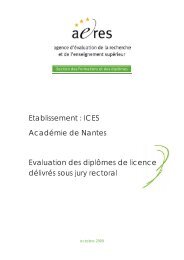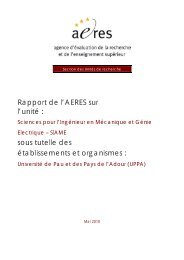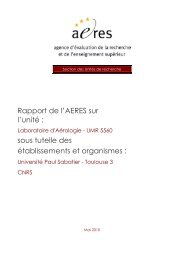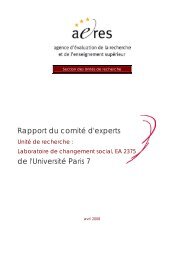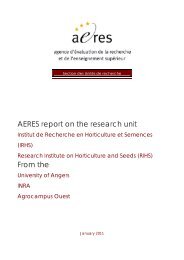Institute for Research on Cancer and Ageing of Nice - Aeres
Institute for Research on Cancer and Ageing of Nice - Aeres
Institute for Research on Cancer and Ageing of Nice - Aeres
You also want an ePaper? Increase the reach of your titles
YUMPU automatically turns print PDFs into web optimized ePapers that Google loves.
Secti<strong>on</strong> des Unités de recherche<br />
AERES report <strong>on</strong> the research unit<br />
<str<strong>on</strong>g>Institute</str<strong>on</strong>g> <str<strong>on</strong>g>for</str<strong>on</strong>g> <str<strong>on</strong>g>Research</str<strong>on</strong>g> <strong>on</strong> <strong>Cancer</strong> <strong>and</strong> <strong>Ageing</strong> <strong>of</strong> <strong>Nice</strong><br />
From the<br />
University <strong>of</strong> <strong>Nice</strong> Sophia-Antipolis<br />
Inserm<br />
CNRS<br />
February 2011
Secti<strong>on</strong> des Unités de recherche<br />
AERES report <strong>on</strong> the research unit<br />
<str<strong>on</strong>g>Institute</str<strong>on</strong>g> <str<strong>on</strong>g>for</str<strong>on</strong>g> <str<strong>on</strong>g>Research</str<strong>on</strong>g> <strong>on</strong> <strong>Cancer</strong> <strong>and</strong> <strong>Ageing</strong> <strong>of</strong> <strong>Nice</strong><br />
From the<br />
University <strong>of</strong> <strong>Nice</strong> Sophia-Antipolis<br />
Inserm<br />
CNRS<br />
February 2011
<str<strong>on</strong>g>Research</str<strong>on</strong>g> Unit<br />
Name <strong>of</strong> the research unit: <str<strong>on</strong>g>Institute</str<strong>on</strong>g> <str<strong>on</strong>g>for</str<strong>on</strong>g> <str<strong>on</strong>g>Research</str<strong>on</strong>g> <strong>on</strong> <strong>Cancer</strong> <strong>and</strong> <strong>Ageing</strong> <strong>of</strong> <strong>Nice</strong><br />
Requested label: UMR CNRS<br />
Name <strong>of</strong> the director: Mr Eric GILSON<br />
Members <strong>of</strong> the review committee<br />
Committee chairman<br />
Mr Patrick MEHLEN, University Claude Bernard, Ly<strong>on</strong>, France<br />
Other committee members<br />
Mr Serge BOITEUX, CEA, F<strong>on</strong>tenay-aux-Roses, France (CoNRS)<br />
Mr Cédric BLANPAIN, Université Libre de Bruxelles, Brussels, Belgium<br />
Mr Hugues DE THE, Université Paris-Diderot, Paris, France<br />
Mr Li<strong>on</strong>el LARUE, Institut Curie, Orsay, France (Inserm CSS)<br />
Ms Christine PERRET, Université Paris-Descartes, Paris, France (Inserm CSS)<br />
Mr Giovanni ROMEO, University <strong>of</strong> Bologna, Bologna, Italy<br />
Mr Lenhard RUDOLPH, University <strong>of</strong> Ulm, Ulm, Germany<br />
Ms Marina SCHORPP-KISTNER, DKFZ, Heidelberg, Germany<br />
Mr Jean Yves SCOAZEC, University <strong>of</strong> Ly<strong>on</strong>, Ly<strong>on</strong>, France<br />
Observers<br />
AERES scientific advisor<br />
Mr Pierre LEGRAIN<br />
University, School <strong>and</strong> <str<strong>on</strong>g>Research</str<strong>on</strong>g> Organizati<strong>on</strong> representatives<br />
Mr Jean Marc LARDEAUX, University <strong>of</strong> <strong>Nice</strong> Sophia-Antipolis<br />
Ms Urszula HIBNER, CNRS<br />
Ms Chantal LASSERRE, Inserm<br />
3
Report<br />
1 � Introducti<strong>on</strong><br />
� Date <strong>and</strong> executi<strong>on</strong> <strong>of</strong> the visit<br />
The <strong>on</strong>-site visit took place <strong>on</strong> February 15th <strong>and</strong> 16th 2011. Eric Gils<strong>on</strong> the director <strong>of</strong> the postulating center<br />
presented the IRCAN center to the committee that subsequently discussed with the 11 founding <strong>and</strong> postulating teams<br />
<strong>of</strong> this center. Visit had been prepared by a very well-organized <strong>and</strong> complete document <strong>and</strong> the evaluati<strong>on</strong> took<br />
place under excellent c<strong>on</strong>diti<strong>on</strong>s.<br />
� History <strong>and</strong> geographical localizati<strong>on</strong> <strong>of</strong> the research unit, <strong>and</strong> brief<br />
presentati<strong>on</strong> <strong>of</strong> its field <strong>and</strong> scientific activities<br />
The IRCAN project reflects the wish <strong>of</strong> local instituti<strong>on</strong>s to create a research center dedicated to cancer <strong>and</strong><br />
aging <strong>on</strong> the Pasteur campus in <strong>Nice</strong>. The unique setting <strong>of</strong> a university campus associated with two hospitals is<br />
definitely a great plus <str<strong>on</strong>g>for</str<strong>on</strong>g> IRCAN. The IRCAN should be led by Eric Gils<strong>on</strong> who was recruited PU-PH in <strong>Nice</strong> 2 years ago<br />
<strong>and</strong> currently gathers up to 11 teams, with quite different backgrounds, even though most teams could be identified<br />
as developing molecular <strong>and</strong> cellular biology.<br />
� Management team<br />
The IRCAN wishes to have a « classic » operati<strong>on</strong>al management team with a director, a deputy-director, a<br />
board composed <strong>of</strong> the team principal investigators <strong>and</strong> a scientific advisory board (SAB). The existing SAB is supposed<br />
to meet <strong>on</strong>ce a year <strong>and</strong> makes recommendati<strong>on</strong>s <strong>on</strong> the general scientific orientati<strong>on</strong>. The director is a renowned<br />
internati<strong>on</strong>al expert in the telomerase field <strong>and</strong> an EMBO member.<br />
� Staff members (<strong>on</strong> the basis <strong>of</strong> the applicati<strong>on</strong> file submitted to the<br />
AERES)<br />
Past Future<br />
N1: Number <strong>of</strong> researchers with teaching duties (Form 2.1 <strong>of</strong> the<br />
applicati<strong>on</strong> file)<br />
19 19<br />
N2: Number <strong>of</strong> full time researchers from research organizati<strong>on</strong>s<br />
(Form 2.3 <strong>of</strong> the applicati<strong>on</strong> file)<br />
26 20<br />
N3: Number <strong>of</strong> other researchers including postdoctoral fellows<br />
(Form 2.2 <strong>and</strong> 2.4 <strong>of</strong> the applicati<strong>on</strong> file)<br />
34 31<br />
N4: Number <strong>of</strong> engineers, technicians <strong>and</strong> administrative staff with<br />
a tenured positi<strong>on</strong> (Form 2.5 <strong>of</strong> the applicati<strong>on</strong> file)<br />
23 21<br />
N5: Number engineers, technicians <strong>and</strong> administrative staff<br />
without a tenured positi<strong>on</strong> (Form 2.6 <strong>of</strong> the applicati<strong>on</strong> file)<br />
14<br />
N6: Number <strong>of</strong> Ph.D. students (Form 2.7 <strong>of</strong> the applicati<strong>on</strong> file) 22<br />
N7: Number <strong>of</strong> staff members with a HDR or a similar grade 36 29<br />
4
2 � Overall appreciati<strong>on</strong> <strong>on</strong> the research unit<br />
� Summary<br />
The appreciati<strong>on</strong> <strong>of</strong> the research unit was <strong>on</strong> the overall positive. Major strengths include the talent <strong>of</strong> the<br />
director, the setting <strong>of</strong> the laboratory in the Pasteur tower, an ideal locati<strong>on</strong> to develop bench-to-bedside research in<br />
cancer <strong>and</strong> aging, <strong>and</strong> the obvious will <strong>of</strong> the local instituti<strong>on</strong>s to federate <strong>and</strong> support top-quality research in this<br />
locati<strong>on</strong>. The absence <strong>of</strong> external recruitment together with the fact that <strong>on</strong>ly some <strong>of</strong> the proposed groups actually<br />
work <strong>on</strong> cancer <strong>and</strong>/or aging must be rapidly corrected by making every ef<str<strong>on</strong>g>for</str<strong>on</strong>g>t to attract new group leaders with<br />
internati<strong>on</strong>al visibility. This requires maintaining a sufficient amount <strong>of</strong> free space, rapid acquisiti<strong>on</strong> <strong>of</strong> a few missing<br />
equipments, the extensi<strong>on</strong> <strong>of</strong> the animal house, <strong>and</strong> a c<strong>on</strong>tinued high level <strong>of</strong> support from local <strong>and</strong> nati<strong>on</strong>al bodies.<br />
� Strengths <strong>and</strong> opportunities<br />
The evaluati<strong>on</strong> committee has identified multiple strengths: most importantly, the scientific excellence <strong>of</strong> the<br />
director <strong>of</strong> IRCAN; then a few highly recognized senior researchers <strong>and</strong> some promising young principal investigators.<br />
The strengths also include good technical plat<str<strong>on</strong>g>for</str<strong>on</strong>g>ms, which appear to be in phase with the needs <strong>of</strong> IRCAN. It was<br />
striking <str<strong>on</strong>g>for</str<strong>on</strong>g> the committee to see how high the expectati<strong>on</strong>s <str<strong>on</strong>g>for</str<strong>on</strong>g> IRCAN are: there is a clear will <strong>of</strong> the <strong>Nice</strong> <strong>and</strong><br />
regi<strong>on</strong>al instituti<strong>on</strong>s to support IRCAN, there was an effective support from INSERM, CNRS, Universities in terms <strong>of</strong><br />
equipment, technicians, engineers over the past two years. Moreover, it appeared clear from the discussi<strong>on</strong> with the<br />
various pers<strong>on</strong>als (staff scientists, ITA, post-doc <strong>and</strong> students), that there is a comm<strong>on</strong> wish from them to engage into<br />
a comm<strong>on</strong> project. Because IRCAN will need new talents to acquire visibility, the proposed « team nursery », an open<br />
space ready to welcome young small groups which need to mature be<str<strong>on</strong>g>for</str<strong>on</strong>g>e becoming identified teams, is an excellent<br />
project that should be realized.<br />
The topic <strong>of</strong> cancer <strong>and</strong> aging is <strong>of</strong> course <strong>of</strong> major interest <strong>and</strong> there are no dedicated centers willing to link<br />
these two fields in France. Moreover, thanks to its close vicinity with the <strong>Nice</strong> public hospital <strong>and</strong> the anti-cancer<br />
center A. Lacassagne (CAL), the IRCAN may adequately develop high potential basic research but also a research<br />
which may be transferred to the clinic. Al<strong>on</strong>g this line, a clear support from University hospital <strong>and</strong> Centre Lacassagne<br />
(CAL) was given.<br />
� Weaknesses <strong>and</strong> threats<br />
The committee identified some significant weaknesses during the visit. The most obvious <strong>on</strong>e is the geopolitical<br />
aspect. According to the Plan <strong>Cancer</strong>, it has been proposed to have <strong>on</strong>ly a few highly visible centers <strong>of</strong> excellence <str<strong>on</strong>g>for</str<strong>on</strong>g><br />
cancer research in France. <strong>Nice</strong> appears to go in an inverse directi<strong>on</strong>. Some good groups working <strong>on</strong> cancer in the<br />
Pasteur campus have moved to another locati<strong>on</strong> to be part <strong>of</strong> a laboratory developing a theme <strong>on</strong> cancer <strong>and</strong><br />
metabolism (<strong>on</strong>e <strong>of</strong> the str<strong>on</strong>g themes developed in IRCAN with the presence <strong>of</strong> a world leader in this field). Also, the<br />
c<strong>on</strong>necti<strong>on</strong> with groups working in the theme <strong>of</strong> development <strong>and</strong> cancer now located in S<strong>of</strong>ia-Antipolis appears to be<br />
lost with the separati<strong>on</strong> from the Institut de Biologie du Développement <strong>and</strong> <strong>Cancer</strong>. The committee recognizes that it<br />
may be difficult to c<strong>on</strong>ciliate within the same town all the research groups addressing cancer research due to various<br />
c<strong>on</strong>siderati<strong>on</strong>s, but the committee expressed c<strong>on</strong>cerns that the nati<strong>on</strong>al <strong>and</strong> internati<strong>on</strong>al visibility <strong>of</strong> IRCAN may be<br />
limited <strong>and</strong> diluted because <strong>of</strong> the existence <strong>of</strong> three centers/institutes addressing cancer research in <strong>Nice</strong>.<br />
Another identified weakness is that, so far, the 11 groups under the present evaluati<strong>on</strong> were all from <strong>Nice</strong>.<br />
Even though the two founding words <strong>of</strong> IRCAN are cancer <strong>and</strong> ageing, there were significant c<strong>on</strong>cerns that <str<strong>on</strong>g>for</str<strong>on</strong>g>ces <strong>on</strong><br />
ageing <strong>and</strong> cancer were so far limited. As noted by the Director himself the future <strong>of</strong> the IRCAN <strong>and</strong> its attractiveness<br />
will also depend <strong>on</strong> the recruitment <strong>of</strong> new groups outside <strong>of</strong> <strong>Nice</strong>.<br />
As a threat, the evaluati<strong>on</strong> committee expressed c<strong>on</strong>cerns about the animal facility, which is so far limited in<br />
terms <strong>of</strong> space, but also in terms <strong>of</strong> experience <strong>and</strong> tools allowing explorati<strong>on</strong> <strong>of</strong> animal models. As a side-practical<br />
recommendati<strong>on</strong>, the project addressing the extensi<strong>on</strong> <strong>of</strong> the animal facility should receive counseling by experts in<br />
the field <strong>of</strong> animal models <strong>and</strong> facilities as c<strong>on</strong>cerns were raised <strong>on</strong> the danger to c<strong>on</strong>struct A1-A2-A3 c<strong>on</strong>tainments<br />
within the same building.<br />
Another possible threat as viewed by the evaluati<strong>on</strong> committee is that following the opening <strong>of</strong> IRCAN, the<br />
center may face a decreased support from the regi<strong>on</strong> <strong>and</strong> the university.<br />
5
� Recommendati<strong>on</strong>s<br />
As a c<strong>on</strong>sequence <strong>of</strong> the above weaknesses <strong>and</strong> threats, the major recommendati<strong>on</strong> lies in two words :<br />
attractiveness <strong>and</strong> excellence in the fields <strong>of</strong> cancer <strong>and</strong> aging. It is <strong>of</strong> key importance <str<strong>on</strong>g>for</str<strong>on</strong>g> IRCAN to attract young<br />
promising new groups, as well as more advanced senior groups. The possible venue, commented during the visit by the<br />
director <strong>of</strong> IRCAN, <strong>of</strong> a group leader developing a work <strong>on</strong> C. elegans <strong>and</strong> aging is a good indicati<strong>on</strong> <strong>of</strong> the ability <strong>of</strong><br />
the IRCAN to become more attractive in this field. However, c<strong>on</strong>tinued emphasis should be given to attractiveness<br />
(possibly independently <strong>of</strong> the ATIPE-Avenir programme). Al<strong>on</strong>g the same line, since two principal investigators <str<strong>on</strong>g>for</str<strong>on</strong>g> the<br />
most visible teams, are close to retirement, the next 6 years should be used to actively promote the emergence <strong>of</strong><br />
leaders who will allow the c<strong>on</strong>tinuati<strong>on</strong> <strong>of</strong> the excellent research per<str<strong>on</strong>g>for</str<strong>on</strong>g>med by these two groups.<br />
As a side-practical recommendati<strong>on</strong>, the project addressing the extensi<strong>on</strong> <strong>of</strong> the animal facility should receive<br />
counseling by experts in the field <strong>of</strong> animal models <strong>and</strong> facilities to ensure the building <strong>of</strong> a state-<strong>of</strong>-the-art animal<br />
facility.<br />
� Producti<strong>on</strong> results<br />
A1: Number <strong>of</strong> permanent researchers with teaching duties 19<br />
(recorded in N1) who are active in research<br />
A2: Number <strong>of</strong> permanent researchers without teaching duties 26<br />
(recorded in N2) who are active in research<br />
A3: Ratio <strong>of</strong> members who are active in research am<strong>on</strong>g staff 1<br />
members [(A1 + A2)/(N1 + N2)]<br />
A4: Number <strong>of</strong> HDR granted during the past 4 years 7<br />
A5: Number <strong>of</strong> PhD granted during the past 4 years 30<br />
3 � Specific comments<br />
� Appreciati<strong>on</strong> <strong>on</strong> the results<br />
The IRCAN project is built around 11 teams working <strong>on</strong> different fields. The proposal described the aim to unify<br />
their strengths to build a center dedicated to cancer <strong>and</strong> aging. The different themes covered so far include:<br />
-A basic research <strong>on</strong> telomeres in yeast <strong>and</strong> more recently in human cells which has been proven to be<br />
excellent headed by an internati<strong>on</strong>ally highly recognized leader –i.e., EMBO member, senior author in the best<br />
journals such as Cell-.<br />
-A basic to translati<strong>on</strong>al research <strong>on</strong> cancer <strong>and</strong> metabolism headed by <strong>on</strong>e <strong>of</strong> the most prestigious French<br />
biologists –EMBO member, president <strong>of</strong> the INCA SAB, member <strong>of</strong> the nati<strong>on</strong>al Academy <strong>of</strong> Sciences.<br />
-A basic to translati<strong>on</strong>al research <strong>on</strong> neutrophils <strong>and</strong> cancer led by a pathologist. This group with a l<strong>on</strong>g-lasting<br />
experience <strong>on</strong> inflammati<strong>on</strong> <strong>and</strong> cancer attested by a large number <strong>of</strong> good publicati<strong>on</strong>s developed a promising line <strong>of</strong><br />
research <strong>on</strong> miRNA, which was recently acknowledged by a paper published in Nat Genetics.<br />
-Two junior groups working respectively <strong>on</strong> the field <strong>of</strong> skin homeostasis <strong>and</strong> retrotranspositi<strong>on</strong> in human<br />
cancer. Both groups were recognized as promising groups having achieved extremely good post-doctoral works<br />
published in excellent journals –i.e., PNAS, J Clin Invest, J Biol Chem, J Cell Biol <strong>and</strong> J Biol Chem, EMBO J, Mol Cell,<br />
Nature Methods -. Projects were positively evaluated with a focused <strong>and</strong> well-c<strong>on</strong>ducted approach in <strong>on</strong>e case <strong>and</strong><br />
with a highly innovative project with great potential in the sec<strong>on</strong>d case. Both principal investigators however need<br />
now to dem<strong>on</strong>strate by last author publicati<strong>on</strong>s their ability to drive excellent research.<br />
-A basic to translati<strong>on</strong>al research <strong>on</strong> diabetes with a clear wish to go towards diabetes <strong>and</strong> ageing research,<br />
per<str<strong>on</strong>g>for</str<strong>on</strong>g>med by a renowned scientist in the field.<br />
6
-different solid, but somehow less visible, research projects such as studying mitoch<strong>on</strong>drial diseases <strong>and</strong> the<br />
stability <strong>of</strong> mt-DNA, the identificati<strong>on</strong> <strong>of</strong> gene mutati<strong>on</strong>s in key signaling pathways in sarcomas, the efficacy <strong>of</strong> antiangiogenic<br />
treatments in renal cancers, the implicati<strong>on</strong> <strong>and</strong> role <strong>of</strong> cancer stem cells in glioblastoma <strong>and</strong> the<br />
relevance <strong>of</strong> cancer-associated fibroblasts in skin cancer.<br />
� Appreciati<strong>on</strong> <strong>on</strong> the impact, the attractiveness <strong>of</strong> the research unit <strong>and</strong><br />
<strong>of</strong> the quality <strong>of</strong> its links with internati<strong>on</strong>al, nati<strong>on</strong>al <strong>and</strong> local partners<br />
The attractiveness <strong>of</strong> IRCAN has to be dem<strong>on</strong>strated, as this is a de novo creati<strong>on</strong>. This is actually <strong>on</strong>e <strong>of</strong> the<br />
main recommendati<strong>on</strong>s from the committee. However, it is important to note that there are already highly recognized<br />
scientists in IRCAN, who represent the stepping-st<strong>on</strong>e <strong>of</strong> IRCAN. 2 PI are EMBO members, 1 is a member <strong>of</strong> the<br />
nati<strong>on</strong>al academy <strong>of</strong> Science <strong>and</strong> is president <strong>of</strong> the INCA SAB. From the internati<strong>on</strong>al visibility point <strong>of</strong> view, 3 PI are<br />
truly outst<strong>and</strong>ing with a large number <strong>of</strong> invitati<strong>on</strong>s at internati<strong>on</strong>al meetings. An important heterogeneity can be<br />
noted am<strong>on</strong>g the different team leaders, the core <strong>of</strong> the IRCAN is being held so far by 4 groups which clearly attract<br />
most <str<strong>on</strong>g>for</str<strong>on</strong>g>eign post-doctoral fellows. Most <strong>of</strong> the proposed teams have dem<strong>on</strong>strated their ability to obtain significant<br />
grant support, so that running costs should not be a major issue <strong>of</strong> the IRCAN.<br />
� Appreciati<strong>on</strong> <strong>on</strong> the management <strong>and</strong> life <strong>of</strong> the research unit<br />
A major strength <strong>of</strong> the IRCAN is its director who is an outst<strong>and</strong>ing scientist <strong>and</strong> appeared as a very capable<br />
<strong>and</strong> energetic director. The IRCAN presentati<strong>on</strong> appeared like a coherent project with adequate scientific animati<strong>on</strong> –<br />
weekly seminar, presence <strong>of</strong> a prestigious SAB-, adequate technical plat<str<strong>on</strong>g>for</str<strong>on</strong>g>ms, will to attract young groups, etc…-.<br />
Most PIs present their work in nati<strong>on</strong>al <strong>and</strong> internati<strong>on</strong>al meetings allowing the disseminati<strong>on</strong> <strong>of</strong> the knowledge<br />
produced by IRCAN. 26 researchers have teaching duties within <strong>Nice</strong>-Sophia Antipolis University allowing the c<strong>on</strong>tact<br />
with undergraduate students <strong>and</strong> permitting the disseminati<strong>on</strong> <strong>of</strong> the IRCAN research programs.<br />
� Appreciati<strong>on</strong> <strong>on</strong> the scientific strategy <strong>and</strong> the project<br />
To link between aging <strong>and</strong> cancer is a timely <strong>and</strong> exciting project. It is indeed more <strong>and</strong> more clear that<br />
prevalence <strong>of</strong> cancer within the elderly populati<strong>on</strong> is very much increased, but the mechanisms are still unclear.<br />
Several instituti<strong>on</strong>s in the world have dedicated their projects to this aim. There<str<strong>on</strong>g>for</str<strong>on</strong>g>e, the evaluati<strong>on</strong> committee found<br />
it compelling to use cancer <strong>and</strong> aging as the leading words <str<strong>on</strong>g>for</str<strong>on</strong>g> IRCAN. The first merit <strong>of</strong> IRCAN will be that to attract<br />
scientists more <strong>and</strong> more interested in this field. However so far, no group recruited at IRCAN actually has presented<br />
a research program that indeed links aging to cancer. Thus, it will be a major challenge <str<strong>on</strong>g>for</str<strong>on</strong>g> the future <strong>of</strong> IRCAN to<br />
recruit new <str<strong>on</strong>g>for</str<strong>on</strong>g>ces having their focus in such a project. It is however important to note that several key projects were<br />
presented harboring high potential in terms <strong>of</strong> both basic <strong>and</strong> translati<strong>on</strong>al research.<br />
7
4 � Appreciati<strong>on</strong> team by team<br />
Team 1 : Telomere, senescence <strong>and</strong> <strong>Cancer</strong><br />
Team Leader : Eric Gils<strong>on</strong><br />
� Staff members<br />
Past Future<br />
N1: Number <strong>of</strong> researchers with teaching duties (Form 2.1 <strong>of</strong> the<br />
applicati<strong>on</strong> file)<br />
1 2<br />
N2: Number <strong>of</strong> full time researchers from research organizati<strong>on</strong>s<br />
(Form 2.3 <strong>of</strong> the applicati<strong>on</strong> file)<br />
2 2<br />
N3: Number <strong>of</strong> other researchers including postdoctoral fellows<br />
(Form 2.2 <strong>and</strong> 2.4 <strong>of</strong> the applicati<strong>on</strong> file)<br />
4 6<br />
N4: Number <strong>of</strong> engineers, technicians <strong>and</strong> administrative staff with 3 2<br />
a tenured positi<strong>on</strong> (Form 2.5 <strong>of</strong> the applicati<strong>on</strong> file)<br />
(1SC<br />
incl.)<br />
N5: Number <strong>of</strong> engineers, technicians <strong>and</strong> administrative staff<br />
without a tenured positi<strong>on</strong> (Form 2.6 <strong>of</strong> the applicati<strong>on</strong> file)<br />
1<br />
N6: Number <strong>of</strong> Ph.D. students (Form 2.7 <strong>of</strong> the applicati<strong>on</strong> file) 3<br />
N7: Number <strong>of</strong> staff members with a HDR or a similar grade 2 3<br />
� Appreciati<strong>on</strong> <strong>on</strong> the results<br />
The team is composed <strong>of</strong> 18 pers<strong>on</strong>s: 6 researchers, 3 technicians/engineers, 6 post-doctoral fellows <strong>and</strong> 3 PhD<br />
students. The size <strong>of</strong> the team is coherent with the proposed research program. The high number <strong>of</strong> post-docs <strong>and</strong><br />
students reveals the dynamics <strong>of</strong> the group. The team investigates structural <strong>and</strong> functi<strong>on</strong>al aspects <strong>of</strong> telomeres<br />
biology using budding yeast <strong>and</strong> mammalian cells in culture as models. The team has a leadership positi<strong>on</strong> at the<br />
internati<strong>on</strong>al level in this highly competitive field <strong>of</strong> research. The scientific activity <strong>of</strong> the team is assessed by the<br />
publicati<strong>on</strong> <strong>of</strong> 52 articles in peer-reviewed journals (2006-2010). Every year, the team published in high ranked<br />
journals with E. Gils<strong>on</strong> or a team member as first/last authors: EMBO J (2006 & 2009), Current Biol (2006), NSMB<br />
(2006 & 2007), Nature Cell Biol (2009) or Cell (2010). They also publish important collaborative work with leader<br />
groups in the field, nati<strong>on</strong>al <strong>and</strong> internati<strong>on</strong>al. One should also note invited reviews in the best journals such as<br />
Nature Rev Mol cell or Mol Cell. The pers<strong>on</strong>al impact <strong>of</strong> E. Gils<strong>on</strong> is also assessed by invitati<strong>on</strong>s in major scientific<br />
events as speaker <strong>and</strong> chairpers<strong>on</strong> such as AACR-C<strong>on</strong>ference, Keyst<strong>on</strong>e symposia, CSH symposia. He also obtained<br />
important scientific awards in 2010: Eurocancer <strong>and</strong> Allianz-Institut de France. The team is str<strong>on</strong>gly supported<br />
financially by nati<strong>on</strong>al <strong>and</strong> European agencies, thus it has the possibility to develop its ambitious research program.<br />
The research project <str<strong>on</strong>g>for</str<strong>on</strong>g> the 4 next years is in the c<strong>on</strong>tinuity <strong>of</strong> the past research <strong>and</strong>, in additi<strong>on</strong> proposes novel<br />
issues. The research will be focused <strong>on</strong> the biological, biochemical <strong>and</strong> structural properties <strong>of</strong> telomeric proteins<br />
such as the telomerase complex (hTERT), TRF2 <strong>and</strong> APOLLO. The c<strong>on</strong>centrati<strong>on</strong> <strong>of</strong> ef<str<strong>on</strong>g>for</str<strong>on</strong>g>ts <strong>on</strong> the TRF2 protein is<br />
certainly a very good issue. Several collaborati<strong>on</strong>s are developed with other IRCAN members in the field <strong>of</strong> cancer.<br />
� Appreciati<strong>on</strong> <strong>on</strong> the impact, the attractiveness <strong>of</strong> the team <strong>and</strong> <strong>of</strong> the<br />
quality <strong>of</strong> its links with internati<strong>on</strong>al, nati<strong>on</strong>al <strong>and</strong> local partners<br />
Attractiveness is obvious because <strong>of</strong> the quality <strong>of</strong> research achievements <strong>and</strong> project (see previous secti<strong>on</strong>).<br />
The high number <strong>of</strong> post-doctoral fellows <strong>and</strong> PhD students also points to attractiveness. The group is very well<br />
funded with nati<strong>on</strong>al <strong>and</strong> European grants (ANR, EMBO, ARC, Label LNC). The group has nati<strong>on</strong>al <strong>and</strong> internati<strong>on</strong>al<br />
collaborati<strong>on</strong>s assessed by comm<strong>on</strong> publicati<strong>on</strong>s with leading groups in Marseille, Basel (Switzerl<strong>and</strong>) <strong>and</strong> Denmark.<br />
8
� Appreciati<strong>on</strong> <strong>on</strong> the scientific strategy <strong>and</strong> the project<br />
The team strategy <strong>and</strong> the projects are ambitious <strong>and</strong> in good agreement with the financial <strong>and</strong> human <str<strong>on</strong>g>for</str<strong>on</strong>g>ces<br />
in the laboratory. The projects are mostly basic research in molecular biology, but also translati<strong>on</strong>al in the fields <strong>of</strong><br />
cancer biology <strong>and</strong> pharmacology. The integrati<strong>on</strong> in the IRCAN seems promising because <strong>of</strong> already <strong>on</strong>going<br />
collaborati<strong>on</strong>s. The project <strong>of</strong> the team focuses <strong>on</strong> fundamental research, which is essential <str<strong>on</strong>g>for</str<strong>on</strong>g> the team but also the<br />
IRCAN.<br />
� C<strong>on</strong>clusi<strong>on</strong>:<br />
� Summary<br />
This is an excellent group at the cutting edge <strong>of</strong> the field. The projects are excellent <strong>and</strong> highly competitive.<br />
This is with no c<strong>on</strong>test a leading team at the internati<strong>on</strong>al level.<br />
� Strengths <strong>and</strong> opportunities<br />
The quality <strong>of</strong> the results as assessed by publicati<strong>on</strong>s in the best journals. The pers<strong>on</strong>al impact <strong>of</strong> E. Gils<strong>on</strong> as<br />
assessed by “invited reviews” in major journals <strong>and</strong> invitati<strong>on</strong>s to meetings. The compositi<strong>on</strong> <strong>of</strong> the group with several<br />
post-docs <strong>and</strong> students.<br />
� Weaknesses <strong>and</strong> threats<br />
The <strong>on</strong>ly possible c<strong>on</strong>cern raised by the committee is the overload <strong>of</strong> administrative tasks in the c<strong>on</strong>text <strong>of</strong><br />
IRCAN with at least eleven groups with very different aims.<br />
� Recommendati<strong>on</strong>s<br />
The <strong>on</strong>ly recommendati<strong>on</strong> <str<strong>on</strong>g>for</str<strong>on</strong>g> this group is to c<strong>on</strong>tinue the excellence that this group has developed over the<br />
last past years. In the c<strong>on</strong>text <strong>of</strong> IRCAN, the committee thinks the recruitment <strong>of</strong> other str<strong>on</strong>g basic research oriented<br />
groups (nati<strong>on</strong>al <strong>and</strong> internati<strong>on</strong>al) is m<strong>and</strong>atory. Basic research groups using other biological models such as yeasts<br />
(S. cerevisiae or S. pombe), nematode or drosophila should be associated with IRCAN in the future.<br />
9
Team 2 : Retrotranspos<strong>on</strong> <strong>and</strong> genome plasticity<br />
Team leader : Gaël CRISTOFARI<br />
� Staff members<br />
Past Future<br />
N1: Number <strong>of</strong> researchers with teaching duties (Form 2.1 <strong>of</strong> the<br />
applicati<strong>on</strong> file)<br />
/ /<br />
N2: Number <strong>of</strong> full time researchers from research organizati<strong>on</strong>s<br />
(Form 2.3 <strong>of</strong> the applicati<strong>on</strong> file)<br />
1 1<br />
N3: Number <strong>of</strong> other researchers including postdoctoral fellows<br />
(Form 2.2 <strong>and</strong> 2.4 <strong>of</strong> the applicati<strong>on</strong> file)<br />
1 2<br />
N4: Number <strong>of</strong> engineers, technicians <strong>and</strong> administrative staff with 2 1<br />
a tenured positi<strong>on</strong> (Form 2.5 <strong>of</strong> the applicati<strong>on</strong> file)<br />
(1SC<br />
incl.)<br />
N5: Number <strong>of</strong> engineers, technicians <strong>and</strong> administrative staff<br />
without a tenured positi<strong>on</strong> (Form 2.6 <strong>of</strong> the applicati<strong>on</strong> file)<br />
1<br />
N6: Number <strong>of</strong> Ph.D. students (Form 2.7 <strong>of</strong> the applicati<strong>on</strong> file) 2<br />
N7: Number <strong>of</strong> staff members with a HDR or a similar grade 1 1<br />
� Appreciati<strong>on</strong> <strong>on</strong> the results<br />
This is a young research team starting 2010 with a very str<strong>on</strong>g support by INSERM (CR1 positi<strong>on</strong> <strong>and</strong> AVENIR<br />
label) <strong>and</strong> ERC (young investigator). The team is composed <strong>of</strong> 9 members: 1 researcher, 3 technicians/engineers, 2<br />
post-doctoral fellows <strong>and</strong> 3 PhD students. The results during the past four years are primarily associated with the<br />
team leader’s post-doctoral period. In this laboratory, he investigated the homeostasis <strong>of</strong> telomeres in human cells<br />
<strong>and</strong> primarily the properties <strong>of</strong> the telomerase complex. He published papers in high ranked journals such as EMBO J<br />
(2006) (1/2), PNAS (2007) (2/6), Mol Cell (2007) (1/8). In Ly<strong>on</strong>, as an independent researcher (2008-2009), he<br />
developed research in the telomerase field with a paper in collaborati<strong>on</strong> in MCB (2010). Since 2010, he initiated a new<br />
research program aiming to dissect the mechanisms <strong>of</strong> retro-transpositi<strong>on</strong> in human cells. The project was already<br />
presented two years ago (<str<strong>on</strong>g>for</str<strong>on</strong>g> the UMR creati<strong>on</strong> with a 4 teams structure). The objective is to decipher the cellular<br />
pathways that c<strong>on</strong>trol retro-transpositi<strong>on</strong>, <strong>and</strong> to underst<strong>and</strong> how transposable elements participate in the normal <strong>and</strong><br />
pathological (cancer) remodeling <strong>of</strong> the human genome. He will focus <strong>on</strong> L1 elements <strong>and</strong> their impact <strong>on</strong> genome<br />
stability using very recent <strong>and</strong> powerful global genome approaches. The results are not yet published. This can be<br />
easily understood because <strong>of</strong> the recent settlement <strong>of</strong> the laboratory. Recent results have been presented: i)<br />
identificati<strong>on</strong> <strong>of</strong> a potential L1 regulator protein, ii) development <strong>of</strong> an in vitro assay <str<strong>on</strong>g>for</str<strong>on</strong>g> retro-transpositi<strong>on</strong>.<br />
However, the functi<strong>on</strong>al impact <strong>of</strong> the L1-regulator c<strong>and</strong>idate has not yet been unambiguously dem<strong>on</strong>strated. One<br />
paper is actually under review. There<str<strong>on</strong>g>for</str<strong>on</strong>g>e, it is not easy to appreciate the recent results <strong>of</strong> the team.<br />
� Appreciati<strong>on</strong> <strong>on</strong> the impact, the attractiveness <strong>of</strong> the team <strong>and</strong> <strong>of</strong> the<br />
quality <strong>of</strong> its links with internati<strong>on</strong>al, nati<strong>on</strong>al <strong>and</strong> local partners<br />
It is too early to appreciate the impact <strong>of</strong> this new group in the field <strong>of</strong> transposable elements. The<br />
attractiveness is good assessed by the growing size <strong>of</strong> the group with 2 post-doctoral fellows <strong>and</strong> 3 PhD students. The<br />
impact <strong>of</strong> the group at the nati<strong>on</strong>al <strong>and</strong> internati<strong>on</strong>al level cannot be assessed because <strong>of</strong> the recent creati<strong>on</strong> <strong>of</strong> the<br />
team.<br />
� Appreciati<strong>on</strong> <strong>on</strong> the scientific strategy <strong>and</strong> the project<br />
The team leader has obtained two very str<strong>on</strong>g supports from INSERM (AVENIR) <strong>and</strong> ERC (young investigator<br />
support <str<strong>on</strong>g>for</str<strong>on</strong>g> about 1.7 MEuros) <strong>and</strong> this is an overall very good strategy to attract collaborators <strong>and</strong> develop very<br />
ambitious projects. The project is highly competitive <strong>and</strong> addresses very basic questi<strong>on</strong>s in genome biology in human.<br />
This team proposes to underst<strong>and</strong> molecular mechanisms <strong>of</strong> retro-transpositi<strong>on</strong> using in vitro <strong>and</strong> in vivo approaches.<br />
It also proposes to underst<strong>and</strong> the role <strong>of</strong> transposable elements in genome plasticity <strong>and</strong> cancer. In term <strong>of</strong> strategy,<br />
the recent recruitment <strong>of</strong> an expert in bioin<str<strong>on</strong>g>for</str<strong>on</strong>g>matics was essential to analyze the huge amount <strong>of</strong> data generated.<br />
10
� C<strong>on</strong>clusi<strong>on</strong>:<br />
� Summary<br />
This is a young promising team with a str<strong>on</strong>g financial support from nati<strong>on</strong>al <strong>and</strong> internati<strong>on</strong>al agencies. The<br />
compositi<strong>on</strong> <strong>of</strong> the group is good with a bioin<str<strong>on</strong>g>for</str<strong>on</strong>g>matician, post-docs <strong>and</strong> students. Several collaborati<strong>on</strong>s are<br />
acknowledged in France <strong>and</strong> abroad. Together with the fact that the team leader indeed per<str<strong>on</strong>g>for</str<strong>on</strong>g>med very well during<br />
his PhD <strong>and</strong> post-doctoral training, this group should then produce important results in the near future.<br />
� Strengths <strong>and</strong> opportunities<br />
Very good post-doctoral publicati<strong>on</strong>s in the field <strong>of</strong> telomerase. The new project <strong>on</strong> retro-transpositi<strong>on</strong> in<br />
human cells is attractive <strong>and</strong> ambitious. The financial support <str<strong>on</strong>g>for</str<strong>on</strong>g> 5 years is significant allowing recruitment <strong>of</strong><br />
collaborators.<br />
� Weaknesses <strong>and</strong> threats<br />
The group is young <strong>and</strong> will have to fight to exist in a highly competitive field. We do not know if the scientific<br />
envir<strong>on</strong>ment is sufficient to develop such genomic project at the internati<strong>on</strong>al level. Similar to Eric Gils<strong>on</strong>’s group<br />
recommendati<strong>on</strong>, the recruitment <strong>of</strong> other basic research oriented groups will be very helpful.<br />
� Recommendati<strong>on</strong>s<br />
This is a young group with a great potential. However, the absence <strong>of</strong> producti<strong>on</strong> may be a problem in the near<br />
future. Thus, the team leader should focus <strong>and</strong> finalize <strong>on</strong>e <strong>of</strong> his <strong>on</strong>going projects by a good publicati<strong>on</strong> in the next<br />
two years. Possibly, the research project should be reoriented at the light <strong>of</strong> the results obtained since the creati<strong>on</strong><br />
<strong>of</strong> the team.<br />
Team 3 : Mitoch<strong>on</strong>drial diseases <strong>and</strong> mtDNA stability<br />
Team Leader : Vér<strong>on</strong>ique PAQUIS<br />
� Staff members<br />
Past Future<br />
N1: Number <strong>of</strong> researchers with teaching duties (Form 2.1 <strong>of</strong> the<br />
applicati<strong>on</strong> file)<br />
2 2<br />
N2: Number <strong>of</strong> full time researchers from research organizati<strong>on</strong>s<br />
(Form 2.3 <strong>of</strong> the applicati<strong>on</strong> file)<br />
/ /<br />
N3: Number <strong>of</strong> other researchers including postdoctoral fellows<br />
(Form 2.2 <strong>and</strong> 2.4 <strong>of</strong> the applicati<strong>on</strong> file)<br />
4 4<br />
N4: Number <strong>of</strong> engineers, technicians <strong>and</strong> administrative staff with 3 2<br />
a tenured positi<strong>on</strong> (Form 2.5 <strong>of</strong> the applicati<strong>on</strong> file)<br />
(1SC<br />
incl.)<br />
N5: Number <strong>of</strong> engineers, technicians <strong>and</strong> administrative staff<br />
without a tenured positi<strong>on</strong> (Form 2.6 <strong>of</strong> the applicati<strong>on</strong> file)<br />
2<br />
N6: Number <strong>of</strong> Ph.D. students (Form 2.7 <strong>of</strong> the applicati<strong>on</strong> file) 1<br />
N7: Number <strong>of</strong> staff members with a HDR or a similar grade 2 2<br />
11
� Appreciati<strong>on</strong> <strong>on</strong> the results<br />
The relevance <strong>and</strong> originality <strong>of</strong> the scientific results <strong>of</strong> this team are compatible with its small size. They are<br />
focused <strong>on</strong> diagnostic applicati<strong>on</strong>s <strong>of</strong> mutati<strong>on</strong> identificati<strong>on</strong> <str<strong>on</strong>g>for</str<strong>on</strong>g> different mitoch<strong>on</strong>drial disorders <str<strong>on</strong>g>for</str<strong>on</strong>g> which the team<br />
has developed during these last 5 years appropriate techniques <strong>of</strong> biochemical <strong>and</strong> DNA analysis <strong>of</strong> mitoch<strong>on</strong>drial<br />
respiratory chain defects. This work is there<str<strong>on</strong>g>for</str<strong>on</strong>g>e centered <strong>on</strong> the genetics <strong>of</strong> mitoch<strong>on</strong>drial diseases <strong>and</strong> has been<br />
per<str<strong>on</strong>g>for</str<strong>on</strong>g>med in direct collaborati<strong>on</strong> with the laboratory <strong>of</strong> genetics <strong>and</strong> the Reference Center <str<strong>on</strong>g>for</str<strong>on</strong>g> Mitoch<strong>on</strong>drial Diseases<br />
(CHU <strong>of</strong> <strong>Nice</strong>, Archet 2 Hospital). The link between the work d<strong>on</strong>e so far in the field <strong>of</strong> mitoch<strong>on</strong>drial diseases <strong>and</strong> the<br />
proposed project is not clear.<br />
The team presents a good number <strong>of</strong> cooperative clinical publicati<strong>on</strong>s in the field <strong>of</strong> mitoch<strong>on</strong>drial genetics,<br />
i.e. the PI presents 15 papers dealing mainly with diagnostic findings <strong>on</strong> mitoch<strong>on</strong>drial diseases. The <strong>on</strong>ly published<br />
paper from the team which may be relevant <str<strong>on</strong>g>for</str<strong>on</strong>g> cancer research deals with the role <strong>of</strong> hMSH5 in the regulati<strong>on</strong> <strong>of</strong><br />
hMSH4 subcellular localizati<strong>on</strong>, which was published in 2007 (Expt. Cell Res.) The P.I. <strong>of</strong> the team was not the senior<br />
author in this work. Another recent paper <strong>of</strong> the group -re: the mitoch<strong>on</strong>drial localizati<strong>on</strong> <strong>of</strong> hMSH5 <strong>and</strong> stimulati<strong>on</strong> <strong>of</strong><br />
mtDNA repair after oxidative stress- is quoted by <strong>on</strong>e <strong>of</strong> the team member as under revisi<strong>on</strong> in HMG, but is not<br />
c<strong>on</strong>firmed as accepted in the updated list <strong>of</strong> publicati<strong>on</strong>s. The publicati<strong>on</strong> record <strong>on</strong> hMSH5, which should be the point<br />
<strong>of</strong> strength <strong>of</strong> the project, is there<str<strong>on</strong>g>for</str<strong>on</strong>g>e quite limited.<br />
Finally, a technical report <strong>on</strong> the rapid identificati<strong>on</strong> <strong>of</strong> unknown heteroplasmic mutati<strong>on</strong>s across the entire<br />
human mitoch<strong>on</strong>drial genome (Nature protocols 2006) could be <strong>of</strong> general interest <str<strong>on</strong>g>for</str<strong>on</strong>g> the field <strong>of</strong> mtDNA mutati<strong>on</strong>s<br />
but its potential does not seem to have been fully investigated. The remaining producti<strong>on</strong> <strong>of</strong> the whole team<br />
(including doctoral theses, scientific communicati<strong>on</strong>s, etc.) is centered again <strong>on</strong> studies <strong>of</strong> patients with<br />
mitoch<strong>on</strong>drial disorders or diseases associated with alterati<strong>on</strong>s <strong>of</strong> mitoch<strong>on</strong>drial functi<strong>on</strong> (like Wolfram syndrome <strong>and</strong><br />
type 2 diabetes). Eight additi<strong>on</strong>al papers represent collaborati<strong>on</strong>s initiated by other groups during the same 5 years<br />
period.<br />
This team, which includes, am<strong>on</strong>g others, two researchers with teaching duties, 4 postdoctoral fellows <strong>and</strong> 1<br />
Ph.D. student has received a significant support from the hospital (3 positi<strong>on</strong>s <str<strong>on</strong>g>for</str<strong>on</strong>g> an research engineer). A recent<br />
recruitment through a University appointment occurred recently.<br />
� Appreciati<strong>on</strong> <strong>on</strong> the impact, the attractiveness <strong>of</strong> the team <strong>and</strong> <strong>of</strong> the<br />
quality <strong>of</strong> its links with internati<strong>on</strong>al, nati<strong>on</strong>al <strong>and</strong> local partners<br />
The team <strong>and</strong> its leader are well established at the nati<strong>on</strong>al level in different C<strong>on</strong>sortia <strong>and</strong> Committees<br />
devoted to the development <strong>of</strong> protocols <strong>and</strong> collaborative studies <str<strong>on</strong>g>for</str<strong>on</strong>g> the diagnostics <strong>of</strong> mitoch<strong>on</strong>drial disorders.<br />
They are clearly part <strong>of</strong> a good French network in the field <strong>of</strong> mitoch<strong>on</strong>drial disease but have little internati<strong>on</strong>al<br />
visibility. The team leader is the president <strong>of</strong> the <strong>on</strong>e ARC (Associati<strong>on</strong> pour la recherche c<strong>on</strong>tre le <strong>Cancer</strong>)<br />
committee.<br />
There is no apparent recruitment <strong>of</strong> investigators from abroad except a recent <strong>on</strong>e, who identified Spiky, a<br />
new mitoch<strong>on</strong>drial partner <strong>of</strong> Twinkle helicase, through a 2-hybrid screen while working in Sweden. Spiky might be an<br />
interactor <strong>of</strong> Twinkle. This work is still unpublished, <strong>and</strong> it is not clear how it could c<strong>on</strong>tribute to the proposed<br />
project, if this preliminary finding is developed further.<br />
The participati<strong>on</strong> <strong>of</strong> the group in a European network (EURO-WABB) brought a funding <strong>of</strong> 117 K Euro. Other<br />
fundings come from nati<strong>on</strong>al agencies which have being providing a large financial support.<br />
The team shows evidence that collaborati<strong>on</strong>s <strong>and</strong> partnerships go bey<strong>on</strong>d nati<strong>on</strong>al boundaries.<br />
The numerous appointments <strong>of</strong> the principal investigator in nati<strong>on</strong>al committees illustrate the c<strong>on</strong>tributi<strong>on</strong> <strong>of</strong><br />
the team to the development <strong>of</strong> diagnostics <strong>of</strong> mitoch<strong>on</strong>drial disorders.<br />
� Appreciati<strong>on</strong> <strong>on</strong> the scientific strategy <strong>and</strong> the project<br />
There is a significant problem in identifying the directi<strong>on</strong> that the project will take towards cancer <strong>and</strong>/or<br />
ageing research during the next 4 years. N<strong>on</strong>e <strong>of</strong> the proposed lines <strong>of</strong> investigati<strong>on</strong> has gathered a sufficient amount<br />
<strong>of</strong> data to make this point clear. Am<strong>on</strong>g these, the <strong>on</strong>ly published study <strong>of</strong> the group deals with the cell distributi<strong>on</strong> <strong>of</strong><br />
hMSH5 protein <strong>and</strong> there are significant doubts about its c<strong>on</strong>clusi<strong>on</strong>s (which have not been verified <str<strong>on</strong>g>for</str<strong>on</strong>g> example by<br />
E.M.). Overall, there are several significant questi<strong>on</strong>s <strong>on</strong> the proposed project, including the use <strong>of</strong> overexpressed<br />
proteins in cells, lack <strong>of</strong> details <strong>on</strong> the proteomic studies, analyses <strong>of</strong> KO mice. Since the work in progress is almost<br />
entirely unpublished, it is difficult to judge its reliability.<br />
12
The allocati<strong>on</strong> <strong>of</strong> resources suffers from the uncertainty about the directi<strong>on</strong> the project will take during the<br />
next 4 years.<br />
The gap existing between the research per<str<strong>on</strong>g>for</str<strong>on</strong>g>med at present by the group <strong>and</strong> that <str<strong>on</strong>g>for</str<strong>on</strong>g>eseen in the project<br />
does not c<strong>on</strong>tribute to the c<strong>on</strong>structi<strong>on</strong> <strong>of</strong> a cutting edge strategy.<br />
� C<strong>on</strong>clusi<strong>on</strong> :<br />
� Summary:<br />
The previous work d<strong>on</strong>e in the diagnostics <strong>of</strong> mitoch<strong>on</strong>drial diseases is <strong>of</strong> good quality but the team does not<br />
have a clear strategy <str<strong>on</strong>g>for</str<strong>on</strong>g> research in the field <strong>of</strong> cancer <strong>and</strong>/or ageing. The cell biology aspects <strong>and</strong> the implicati<strong>on</strong>s<br />
<strong>of</strong> the findings <strong>on</strong> MSH5 need to be strengthened. The few preliminary findings, which might lead to the development<br />
<strong>of</strong> an interesting line <strong>of</strong> research -re: the role <strong>of</strong> mitoch<strong>on</strong>dria dysfuncti<strong>on</strong>s in cancer- are at present not sufficiently<br />
str<strong>on</strong>g.<br />
� Strengths <strong>and</strong> opportunities<br />
The team has str<strong>on</strong>g pers<strong>on</strong>nel support from hospital <strong>and</strong> can take advantage <strong>of</strong> the resources deriving from<br />
the clinical <strong>and</strong> molecular diagnostics services per<str<strong>on</strong>g>for</str<strong>on</strong>g>med by the laboratory <strong>of</strong> genetics <strong>and</strong> by the Reference Center<br />
<str<strong>on</strong>g>for</str<strong>on</strong>g> Mitoch<strong>on</strong>drial Diseases.<br />
� Weaknesses <strong>and</strong> threats<br />
The different locati<strong>on</strong>s <strong>of</strong> IRCAN in the Tour Pasteur <strong>and</strong> <strong>of</strong> the Reference Center <str<strong>on</strong>g>for</str<strong>on</strong>g> Mitoch<strong>on</strong>drial Diseases in<br />
the Archet 2 Hospital implies that the same pers<strong>on</strong>nel involved in the research activities in the <str<strong>on</strong>g>for</str<strong>on</strong>g>mer <strong>and</strong> in<br />
diagnostic activities in the latter will apparently have to move from <strong>on</strong>e locati<strong>on</strong> to the other. This will seriously<br />
jeopardize the development <strong>of</strong> the proposed research project. In additi<strong>on</strong>, several basic questi<strong>on</strong>s regarding aspects<br />
<strong>of</strong> fundamental biology <strong>of</strong> mitoch<strong>on</strong>dria remain unanswered like the mitoch<strong>on</strong>drial localizati<strong>on</strong> <strong>of</strong> hMSH5 <strong>and</strong> the<br />
stimulati<strong>on</strong> <strong>of</strong> mtDNA repair mechanisms after oxidative stress. Pursuing these objectives implies the involvement <strong>of</strong><br />
highly trained permanent staff <strong>and</strong> this appears to be lacking.<br />
� Recommendati<strong>on</strong>s<br />
The team should recruit staff scientists, focus <strong>on</strong> a defined topic <strong>and</strong> provide some clear-cut evidence <strong>on</strong> the<br />
importance <strong>of</strong> MSH5 to mitoch<strong>on</strong>drial biology. The team might want also to take more advantage <strong>of</strong> the patients <strong>and</strong><br />
families resources that are available through the laboratory <strong>of</strong> genetics <strong>and</strong> the Reference Center <str<strong>on</strong>g>for</str<strong>on</strong>g> Mitoch<strong>on</strong>drial<br />
Diseases at Archet 2 Hospital. As an example, they could identify new nuclear genes involved in mitoch<strong>on</strong>drial<br />
dysfuncti<strong>on</strong> by using the plat<str<strong>on</strong>g>for</str<strong>on</strong>g>m <strong>of</strong> Next Generati<strong>on</strong> Sequencing available at IRCAN. However, it is not clear how the<br />
in depth study <strong>of</strong> the two available <strong>and</strong> interesting large pedigrees described in the applicati<strong>on</strong> would integrate in the<br />
proposed project.<br />
13
Team 4 : Carcinogenesis-related chr<strong>on</strong>ic active inflammati<strong>on</strong><br />
Team Leader : Paul HOFMAN<br />
� Staff members<br />
Past Future<br />
N1: Number <strong>of</strong> researchers with teaching duties (Form 2.1 <strong>of</strong> the<br />
applicati<strong>on</strong> file)<br />
6 5<br />
N2: Number <strong>of</strong> full time researchers from research organizati<strong>on</strong>s<br />
(Form 2.3 <strong>of</strong> the applicati<strong>on</strong> file)<br />
3 3<br />
N3: Number <strong>of</strong> other researchers including postdoctoral fellows<br />
(Form 2.2 <strong>and</strong> 2.4 <strong>of</strong> the applicati<strong>on</strong> file)<br />
1 2<br />
N4: Number <strong>of</strong> engineers, technicians <strong>and</strong> administrative staff with<br />
a tenured positi<strong>on</strong> (Form 2.5 <strong>of</strong> the applicati<strong>on</strong> file)<br />
1 /<br />
N5: Number <strong>of</strong> engineers, technicians <strong>and</strong> administrative staff<br />
without a tenured positi<strong>on</strong> (Form 2.6 <strong>of</strong> the applicati<strong>on</strong> file)<br />
/<br />
N6: Number <strong>of</strong> Ph.D. students (Form 2.7 <strong>of</strong> the applicati<strong>on</strong> file) 3<br />
N7: Number <strong>of</strong> staff members with a HDR or a similar grade 7 6<br />
� Appreciati<strong>on</strong> <strong>on</strong> the results<br />
The main research interest <strong>of</strong> the group has been <strong>on</strong> the interacti<strong>on</strong>s through chr<strong>on</strong>ic inflammati<strong>on</strong>, pathogens<br />
<strong>and</strong> carcinogenesis, mainly in the digestive tract, <strong>and</strong> more recently in the lung <strong>and</strong> the thyroid. From a morphological<br />
<strong>and</strong> physiological approach, with a degree <strong>of</strong> dispersi<strong>on</strong> in the interests, the team has progressively moved to a more<br />
experimental <strong>and</strong> explicative approach <strong>and</strong> adopted a much more focused project. This was successful <strong>and</strong> led to<br />
important achievements, such as the recent dem<strong>on</strong>strati<strong>on</strong> that apparently silent polymorphisms may be clinically<br />
relevant through the alterati<strong>on</strong>s <strong>of</strong> the interacti<strong>on</strong>s with regulating miRNAs.<br />
The group is highly productive, with a high number <strong>of</strong> ACL (more than 100) <strong>and</strong> 4 patents. However, many are<br />
related to the clinical activities <strong>of</strong> some members <strong>of</strong> the team, <strong>and</strong> are not directly relevant to the main research<br />
objectives. Nevertheless, the relevant publicati<strong>on</strong>s represent a good producti<strong>on</strong> <strong>of</strong> about 30 papers, usually published<br />
until recently in journals with good or very good impact factors (Am J Physiol, PLOS family ...).More recently, the<br />
team reported important new results in an excellent journal (Nature Genet, 2011).<br />
� Appreciati<strong>on</strong> <strong>on</strong> the impact, the attractiveness <strong>of</strong> the team <strong>and</strong> <strong>of</strong> the<br />
quality <strong>of</strong> its links with internati<strong>on</strong>al, nati<strong>on</strong>al <strong>and</strong> local partners<br />
The group has c<strong>on</strong>tracted local <strong>and</strong> nati<strong>on</strong>al partnerships <strong>of</strong> excellent quality <strong>and</strong> relevance to their own<br />
projects.<br />
The team leader shows numerous invitati<strong>on</strong>s <strong>and</strong> participati<strong>on</strong>s in nati<strong>on</strong>al <strong>and</strong> european medical c<strong>on</strong>gresses<br />
(32 invitati<strong>on</strong>s).<br />
The team has proven able to attract three active <strong>and</strong> productive full time researchers in the last 4 years. It<br />
includes a number <strong>of</strong> medical researchers coming from the main areas <strong>of</strong> interest <strong>of</strong> the team <strong>and</strong> testifying the<br />
str<strong>on</strong>g clinical c<strong>on</strong>necti<strong>on</strong>s <strong>of</strong> the group.<br />
It can be noted a good participati<strong>on</strong> to internati<strong>on</strong>al networks, however, mainly in the field <strong>of</strong> biobanking.<br />
The team has a good capacity <strong>of</strong> fund raising (about 1000 k€ from local <strong>and</strong> nati<strong>on</strong>al sources) <strong>and</strong> a recognized<br />
capacity to organize high quality technological plat<str<strong>on</strong>g>for</str<strong>on</strong>g>ms <strong>and</strong> biological resource centers, mainly oriented to support<br />
the own research interests <strong>of</strong> the team.<br />
4 patents have been filed.<br />
14
� Appreciati<strong>on</strong> <strong>on</strong> the scientific strategy <strong>and</strong> the project<br />
The research project is highly focused <strong>on</strong> the role that neutrophils may play a role in tumor progressi<strong>on</strong> <strong>and</strong><br />
disseminati<strong>on</strong>. The main hypothesis <strong>of</strong> the group is that neutrophils may influence the behavior <strong>of</strong> tumor cells,<br />
especially through the release <strong>of</strong> miRNA in their pericellular envir<strong>on</strong>ment. This hypothesis will be explored by an<br />
integrated strategy combining experimental approaches (including animal models) <strong>and</strong> a translati<strong>on</strong>al approach based<br />
<strong>on</strong> well-characterized samples <strong>of</strong> human tumors, available through the local biobank. The general aim <strong>of</strong> the research<br />
is “cutting edge”, clearly original <strong>and</strong> highly innovative, with little competiti<strong>on</strong> at the nati<strong>on</strong>al <strong>and</strong> internati<strong>on</strong>al<br />
levels. The working hypothesis is based <strong>on</strong> recent results <strong>of</strong> the team <strong>and</strong> <strong>on</strong> preliminary observati<strong>on</strong>s; if verified,<br />
results will be very important <strong>and</strong> will open a new directi<strong>on</strong> in the study <strong>of</strong> the interacti<strong>on</strong>s between tumor cells <strong>and</strong><br />
their envir<strong>on</strong>ment.<br />
There is no problem <strong>of</strong> resource allocati<strong>on</strong>s <strong>and</strong> a good adequati<strong>on</strong> between project <strong>and</strong> human resources.<br />
The main research project has the potential to be <strong>of</strong> “cutting edge” <str<strong>on</strong>g>for</str<strong>on</strong>g>mat.<br />
� C<strong>on</strong>clusi<strong>on</strong> :<br />
� Summary<br />
This is an attractive team, with an original <strong>and</strong> innovative research project <strong>and</strong> an excellent inserti<strong>on</strong> in the<br />
local clinical envir<strong>on</strong>ment, resulting in important recent achievements. This team is equally well devoted to basic <strong>and</strong><br />
translati<strong>on</strong>al research <strong>and</strong>, with its str<strong>on</strong>g clinical background, will be a very valuable asset to the future IRCAN.<br />
� Strengths <strong>and</strong> opportunities<br />
Innovative <strong>and</strong> highly focused project, excellent opportunities <strong>of</strong> translati<strong>on</strong>al research, excellent c<strong>on</strong>necti<strong>on</strong>s<br />
with the clinical envir<strong>on</strong>ment, high visibility <strong>of</strong> the team leader, important productivity.<br />
� Weaknesses <strong>and</strong> threats<br />
The bases supporting the working hypothesis have to be str<strong>on</strong>gly established <strong>and</strong> a number <strong>of</strong> alternative<br />
mechanisms <strong>and</strong> possible pitfalls must be carefully excluded.<br />
� Recommendati<strong>on</strong>s<br />
It is important to maintain the highly focused character <strong>of</strong> the project, increase the level <strong>of</strong> participati<strong>on</strong> to<br />
competitive internati<strong>on</strong>al applicati<strong>on</strong>s, increase the scientific visibility <strong>of</strong> the whole team at the nati<strong>on</strong>al <strong>and</strong><br />
especially, internati<strong>on</strong>al levels <strong>and</strong> promote the young researchers <strong>of</strong> the team.<br />
15
Team 5 : <strong>Ageing</strong> <strong>and</strong> Diabetes<br />
Team Leader : Emmanuel VAN OBBERGHEN<br />
� Staff members<br />
Past Future<br />
N1: Number <strong>of</strong> researchers with teaching duties (Form 2.1 <strong>of</strong> the<br />
applicati<strong>on</strong> file)<br />
7 4<br />
N2: Number <strong>of</strong> full time researchers from research organizati<strong>on</strong>s<br />
(Form 2.3 <strong>of</strong> the applicati<strong>on</strong> file)<br />
2 1<br />
N3: Number <strong>of</strong> other researchers including postdoctoral fellows<br />
(Form 2.2 <strong>and</strong> 2.4 <strong>of</strong> the applicati<strong>on</strong> file)<br />
5 6<br />
N4: Number <strong>of</strong> engineers, technicians <strong>and</strong> administrative staff with 3 1<br />
a tenured positi<strong>on</strong> (Form 2.5 <strong>of</strong> the applicati<strong>on</strong> file)<br />
(1SC<br />
incl.)<br />
N5: Number <strong>of</strong> engineers, technicians <strong>and</strong> administrative staff<br />
without a tenured positi<strong>on</strong> (Form 2.6 <strong>of</strong> the applicati<strong>on</strong> file)<br />
2<br />
N6: Number <strong>of</strong> Ph.D. students (Form 2.7 <strong>of</strong> the applicati<strong>on</strong> file) 3<br />
N7: Number <strong>of</strong> staff members with a HDR or a similar grade 8 4<br />
� Appreciati<strong>on</strong> <strong>on</strong> the results<br />
The research focus <strong>on</strong> metabolism <strong>and</strong> ageing is highly relevant <str<strong>on</strong>g>for</str<strong>on</strong>g> the new institute (IRCAN). The prevalence<br />
<strong>of</strong> diabetes <strong>and</strong> obesity is c<strong>on</strong>stantly increasing <strong>and</strong> there<str<strong>on</strong>g>for</str<strong>on</strong>g>e, it is <strong>of</strong> utmost importance to decipher molecular<br />
mechanisms that impair healthy ageing <strong>and</strong> lead to cancer <str<strong>on</strong>g>for</str<strong>on</strong>g>mati<strong>on</strong> under these c<strong>on</strong>diti<strong>on</strong>s.<br />
The group has a significant publicati<strong>on</strong> record <strong>of</strong> 58 publicati<strong>on</strong>s in peer-reviewed journals, am<strong>on</strong>g those 43 as<br />
first <strong>and</strong>/or last author. Most <strong>of</strong> them are in many different specialty medical-oriented journals. Nevertheless, <strong>on</strong>e<br />
may note <strong>on</strong>e publicati<strong>on</strong> in Curr. Biol., two in J. Biol. Chem. <strong>and</strong> <strong>on</strong>e in Oncogene.<br />
However, the number <strong>of</strong> projects is impressive. In future work, the group should focus <strong>on</strong> a subset <strong>of</strong> mostrelevant<br />
projects aiming to get more high-impact paper publicati<strong>on</strong>s.<br />
� Appreciati<strong>on</strong> <strong>on</strong> the impact, the attractiveness <strong>of</strong> the team <strong>and</strong> <strong>of</strong> the<br />
quality <strong>of</strong> its links with internati<strong>on</strong>al, nati<strong>on</strong>al <strong>and</strong> local partners<br />
The team appears to be highly motivated. The planned new institute (IRCAN) has further stimulated the<br />
enthusiasm <strong>of</strong> the group. The inclusi<strong>on</strong> <strong>of</strong> a junior group leader was a smart move to bring in expertise <strong>on</strong> mouse<br />
model <strong>and</strong> miRNAs. This could especially be relevant <str<strong>on</strong>g>for</str<strong>on</strong>g> the functi<strong>on</strong>al analysis <strong>of</strong> newly identified miRNAs that may<br />
be linked to the development <strong>of</strong> metabolic <strong>and</strong> cardiovascular disease. The combinati<strong>on</strong> <strong>of</strong> the experience <strong>of</strong> the<br />
team leader in metabolism <strong>and</strong> the expertise <strong>of</strong> newly arrived scientist in mouse models <strong>and</strong> functi<strong>on</strong>al analysis <strong>of</strong><br />
miRNAs looks like a classical win-win situati<strong>on</strong>. This combinati<strong>on</strong> could be very str<strong>on</strong>g to analyze functi<strong>on</strong>ally the<br />
influence <strong>of</strong> miRNAs <strong>on</strong> metabolism, cancer, <strong>and</strong> possibly aging.<br />
The team leader has a very good internati<strong>on</strong>al st<strong>and</strong>ing. He has received several very prestigious research<br />
awards <strong>and</strong> he is c<strong>on</strong>stantly invited to speak at internati<strong>on</strong>al c<strong>on</strong>ferences. He is involved in several EU projects<br />
indicating his internati<strong>on</strong>al collaborati<strong>on</strong>s. In additi<strong>on</strong>, the group has many nati<strong>on</strong>al collaborati<strong>on</strong>s.<br />
� Appreciati<strong>on</strong> <strong>on</strong> the scientific strategy <strong>and</strong> the project<br />
The research team focuses <strong>on</strong> a very important <strong>and</strong> highly competitive research area –the evoluti<strong>on</strong> <strong>of</strong><br />
diabetes, specifically the influence <strong>of</strong> developmental factors <strong>and</strong> aging-related factors <strong>on</strong> the evoluti<strong>on</strong> <strong>of</strong> diabetes.<br />
The research program is well structured <strong>and</strong> highly innovative. The team should c<strong>on</strong>sider narrowing the focus. Some <strong>of</strong><br />
the work plans <strong>on</strong> organ pathological changes in diabetes (endothelial- -cell interacti<strong>on</strong> in pancreas, kidney) are not<br />
16
supported by str<strong>on</strong>g research results. Other topics appear to be more advanced, specifically the work <strong>on</strong> miRNAs that<br />
are associated with the development <strong>of</strong> diabetes. It would be <strong>of</strong> utmost importance to study the functi<strong>on</strong>al in vivo<br />
relevance <strong>of</strong> these miRNAs in mouse models. The involvement <strong>of</strong> a recently hired scientist <strong>and</strong> the link to<br />
cardiovascular research could be very beneficial <str<strong>on</strong>g>for</str<strong>on</strong>g> this research directi<strong>on</strong>. Eventually, this could lead to the<br />
evoluti<strong>on</strong> <strong>of</strong> a suitable successor <str<strong>on</strong>g>for</str<strong>on</strong>g> the present team leader, who may c<strong>on</strong>sider retirement in 4-5 years.<br />
� C<strong>on</strong>clusi<strong>on</strong><br />
� Summary<br />
In summary, the research group (including the junior group) has a very good track record <strong>and</strong> works <strong>on</strong> a highly<br />
important research topic, which is relevant <str<strong>on</strong>g>for</str<strong>on</strong>g> both aging <strong>and</strong> cancer. The new mechanistic studies <strong>on</strong> miRNAs in<br />
diabetes development <strong>and</strong> cardiovascular disease appear highly attractive <strong>and</strong> if studied in appropriate in vivo models<br />
could be highly successful.<br />
� Strengths <strong>and</strong> opportunities<br />
The visibility <strong>of</strong> the research group. The recent recruitment <strong>of</strong> a junior group leader who could play a major<br />
role in the future development <strong>of</strong> the research project <strong>of</strong> the team. The new focus <strong>on</strong> miRNAs in the epigenetic<br />
c<strong>on</strong>trol <strong>of</strong> gene transcripti<strong>on</strong>, its role in diabetes development, <strong>and</strong> the c<strong>on</strong>sequences <strong>on</strong> cardiovascular disease that<br />
represent a very attractive research topic.<br />
� Weaknesses <strong>and</strong> threats<br />
The possible retirement <strong>of</strong> the team leader in the next 4-5 years.<br />
� Recommendati<strong>on</strong>s<br />
The group publishes well but should try to get more high impact papers. Given the importance <str<strong>on</strong>g>for</str<strong>on</strong>g> aging <strong>and</strong><br />
cancer <strong>of</strong> this topic, it will be important to make plans <str<strong>on</strong>g>for</str<strong>on</strong>g> the c<strong>on</strong>tinuati<strong>on</strong> <strong>of</strong> the research program. If successful, the<br />
project <strong>of</strong> the junior group leader could provide a solid basis <str<strong>on</strong>g>for</str<strong>on</strong>g> a l<strong>on</strong>g term perspective <strong>of</strong> the team.<br />
17
Team 6 : Epithelial homeostasis <strong>and</strong> tumorigenesis<br />
Team leader : Chloé FERAL<br />
� Staff members<br />
Past Future<br />
N1: Number <strong>of</strong> researchers with teaching duties (Form 2.1 <strong>of</strong> the<br />
applicati<strong>on</strong> file)<br />
/ /<br />
N2: Number <strong>of</strong> full time researchers from research organizati<strong>on</strong>s<br />
(Form 2.3 <strong>of</strong> the applicati<strong>on</strong> file)<br />
1 1<br />
N3: Number <strong>of</strong> other researchers including postdoctoral fellows<br />
(Form 2.2 <strong>and</strong> 2.4 <strong>of</strong> the applicati<strong>on</strong> file)<br />
1 2<br />
N4: Number <strong>of</strong> engineers, technicians <strong>and</strong> administrative staff with 2 2<br />
a tenured positi<strong>on</strong> (Form 2.5 <strong>of</strong> the applicati<strong>on</strong> file)<br />
(1SC<br />
incl.)<br />
N5: Number <strong>of</strong> engineers, technicians <strong>and</strong> administrative staff<br />
without a tenured positi<strong>on</strong> (Form 2.6 <strong>of</strong> the applicati<strong>on</strong> file)<br />
3<br />
N6: Number <strong>of</strong> Ph.D. students (Form 2.7 <strong>of</strong> the applicati<strong>on</strong> file) /<br />
N7: Number <strong>of</strong> staff members with a HDR or a similar grade 1 1<br />
� Appreciati<strong>on</strong> <strong>on</strong> the results<br />
During her post-doctoral training, the team leader has been interested in integrins <strong>and</strong> <strong>on</strong>e protein interacting<br />
with them : CD98hc. She developed several original c<strong>on</strong>stitutive <strong>and</strong> c<strong>on</strong>diti<strong>on</strong>al engineered mouse models. The main<br />
goal <strong>of</strong> the project is to evaluate the importance <strong>of</strong> CD98 in the skin using mouse molecular genetics <strong>and</strong> to<br />
investigate the c<strong>on</strong>sequences <strong>of</strong> CD98 deleti<strong>on</strong> <strong>on</strong> skin homeostasis, <strong>and</strong> tumorigenesis. The project is solid <strong>and</strong><br />
focused. The originality <strong>of</strong> this project will be residing in the characterizati<strong>on</strong> <strong>of</strong> the molecular mechanisms<br />
underlying the functi<strong>on</strong> <strong>of</strong> this protein, if indeed the deleti<strong>on</strong> <strong>of</strong> this gene will show a phenotype. Also, since this<br />
protein has a potential dual functi<strong>on</strong>s (regulating integrin signaling <strong>and</strong> participate in the transport <strong>of</strong> aminoacids) this<br />
might be interesting to underst<strong>and</strong>.<br />
Eight articles were published in associati<strong>on</strong> with her post-doc (3 as first authors including a JCI <strong>and</strong> a JCB, 2 as<br />
sec<strong>on</strong>d author in J Exp Med <strong>and</strong> JBC ; she was coauthor in MCB 2008, Nat Immunol 2009, <strong>and</strong> Curr Res 2010). The work<br />
was published in excellent <strong>and</strong> very good journals. The team as such did not produce any publicati<strong>on</strong> yet, but <strong>on</strong>e<br />
paper has been submitted. Since 2006, she was invited in two c<strong>on</strong>ferences <strong>and</strong> per<str<strong>on</strong>g>for</str<strong>on</strong>g>med <strong>on</strong>e oral communicati<strong>on</strong> (2<br />
out <strong>of</strong> 3 in France). The team was created in January 2009 with an AVENIR/INCa grant. The evaluati<strong>on</strong> <strong>of</strong> the team as<br />
such is not feasible <str<strong>on</strong>g>for</str<strong>on</strong>g> the last 4 years period.<br />
� Appreciati<strong>on</strong> <strong>on</strong> the impact, the attractiveness <strong>of</strong> the team <strong>and</strong> <strong>of</strong> the<br />
quality <strong>of</strong> its links with internati<strong>on</strong>al, nati<strong>on</strong>al <strong>and</strong> local partners<br />
The team leader was invited <strong>on</strong>ce to an internati<strong>on</strong>al c<strong>on</strong>ference.<br />
The team will be composed <strong>of</strong> 3 permanents + 3 n<strong>on</strong>-permanents (1 CR2, 2 ITA Inserm + 1 ITA CDD, 2 Postdocs).<br />
One <strong>of</strong> these postdocs was recruited from abroad as a post-doc in a well-known lab. This seems ideal to<br />
rein<str<strong>on</strong>g>for</str<strong>on</strong>g>ce the team.<br />
The team leader c<strong>on</strong>tinues her collaborati<strong>on</strong> with her <str<strong>on</strong>g>for</str<strong>on</strong>g>mer postdoc laboratory <strong>and</strong> started a collaborati<strong>on</strong><br />
with team 7 at IRCAN. Altogether, this is very promising.<br />
The team leader obtained an Avenir grant <strong>and</strong> other fellowship grants. Thus, the team has funding <str<strong>on</strong>g>for</str<strong>on</strong>g> the<br />
running budget <strong>and</strong> n<strong>on</strong>-permanents staffs until 2012.<br />
It appears that the team leader is quite well networked at the local <strong>and</strong> internati<strong>on</strong>al levels.<br />
18
As menti<strong>on</strong>ed, the team has i) a clear <strong>and</strong> focused questi<strong>on</strong>, ii) the appropriate fellows to per<str<strong>on</strong>g>for</str<strong>on</strong>g>m the work,<br />
iii) the fundings, iv) the biological tools <strong>and</strong> v) the structure (lab space, animal col<strong>on</strong>y, histology room, etc..).<br />
However, it is also important to note that up to now, all publicati<strong>on</strong>s come from the very successful postdoctoral<br />
period <strong>of</strong> the team leader. The youth <strong>of</strong> the team makes its visibility per se not yet appreciable.<br />
� Appreciati<strong>on</strong> <strong>on</strong> the scientific strategy <strong>and</strong> the project<br />
The proposed project aims to investigate wound healing <strong>and</strong> skin carcinogenesis in mice with temporal <strong>and</strong>/or<br />
spatial ablati<strong>on</strong> <strong>of</strong> CD98hc in keratinocytes. It will address the physiological role <strong>of</strong> integrins <strong>and</strong> integrin-associated<br />
proteins in keratinocyte biology (adhesi<strong>on</strong> proliferati<strong>on</strong> <strong>and</strong> differentiati<strong>on</strong>, as well as re-epitheliazati<strong>on</strong> during wound<br />
healing <strong>on</strong> <strong>on</strong>e side) but also the involvement <strong>of</strong> altered integrin signaling in skin disorders including cancer. In<br />
parallel, the team will per<str<strong>on</strong>g>for</str<strong>on</strong>g>m functi<strong>on</strong>al studies <strong>on</strong> isolated CD98hc-deficient keratinocytes to assess the impact <strong>of</strong><br />
CD98hc loss, <strong>and</strong> the roles <strong>of</strong> different CD98hc domains <strong>on</strong> integrin signaling. Finally, it is planned to decipher<br />
CD98hc-dependent integrin regulati<strong>on</strong> <strong>and</strong> amino acid transport.<br />
The strategy is straight<str<strong>on</strong>g>for</str<strong>on</strong>g>ward <strong>and</strong> well thought. The chosen methodology is straight<str<strong>on</strong>g>for</str<strong>on</strong>g>ward.<br />
The project is well-planned regarding budget, number <strong>of</strong> pers<strong>on</strong>s <strong>and</strong> questi<strong>on</strong>s.<br />
The project is not highly innovative at this point but is solid. According to the limited resources, the team will<br />
have time to generate original science with other CD98hc partners <strong>and</strong> their roles in skin biology.<br />
� C<strong>on</strong>clusi<strong>on</strong> :<br />
� Summary<br />
The team is working <strong>on</strong> a well-focused aspect <strong>of</strong> the regulati<strong>on</strong> <strong>of</strong> integrin c<strong>on</strong>centrating <strong>on</strong> <strong>on</strong>e specific<br />
protein CD98hc. All the requirements to succeed are fulfilled. This protein has other partners, which can be very<br />
important in the underst<strong>and</strong>ing <strong>of</strong> the functi<strong>on</strong> <strong>of</strong> CD98hc. The proposal is well written.<br />
� Strengths <strong>and</strong> opportunities<br />
The project is well thought <strong>and</strong> feasible. With regard to the available scientific experience <strong>of</strong> the team <strong>and</strong> the<br />
experimental tools, the research plans are well feasible. In vivo model is <strong>of</strong> interest <strong>and</strong> it is quite simple to establish<br />
in vitro models to better evaluate other aspects <strong>of</strong> biology such as biochemistry. The team leader showed that she can<br />
raise m<strong>on</strong>ey.<br />
� Weaknesses <strong>and</strong> threats<br />
Lacks PhD students (no HDR). As a young team leader, she will have to show her quality as a manager. She will<br />
have to hire PhD students <strong>on</strong>ce she will have her HDR. A high quality animal col<strong>on</strong>y is essential <str<strong>on</strong>g>for</str<strong>on</strong>g> this team. The<br />
overall number <strong>of</strong> cages <strong>and</strong> know-how will need to be increased in the near future to allow this team (<strong>and</strong> the<br />
others) to develop their project without a gap <strong>of</strong> 1-2 years. A high impact publicati<strong>on</strong> will be required to allow the<br />
renewal <strong>of</strong> external funding that will run out in 2012.<br />
� Recommendati<strong>on</strong>s<br />
(i) Needs to obtain her HDR as so<strong>on</strong> as possible <strong>and</strong> to recruit PhD student urgently. (ii) Generates close<br />
interacti<strong>on</strong> with pathologists who are present in the centre. (iii) Publish high quality papers.<br />
19
Team 7 : Hypoxia signaling <strong>and</strong> <strong>Cancer</strong> Metabolism<br />
Team leader : Jacques POUYSSEGUR<br />
� Staff members<br />
Past Future<br />
N1: Number <strong>of</strong> researchers with teaching duties (Form 2.1 <strong>of</strong> the<br />
applicati<strong>on</strong> file)<br />
1 1<br />
N2: Number <strong>of</strong> full time researchers from research organizati<strong>on</strong>s<br />
(Form 2.3 <strong>of</strong> the applicati<strong>on</strong> file)<br />
5 5<br />
N3: Number <strong>of</strong> other researchers including postdoctoral fellows<br />
(Form 2.2 <strong>and</strong> 2.4 <strong>of</strong> the applicati<strong>on</strong> file)<br />
9 2<br />
N4: Number <strong>of</strong> engineers, technicians <strong>and</strong> administrative staff with<br />
a tenured positi<strong>on</strong> (Form 2.5 <strong>of</strong> the applicati<strong>on</strong> file)<br />
1 /<br />
N5: Number <strong>of</strong> engineers, technicians <strong>and</strong> administrative staff<br />
without a tenured positi<strong>on</strong> (Form 2.6 <strong>of</strong> the applicati<strong>on</strong> file)<br />
/<br />
N6: Number <strong>of</strong> Ph.D. students (Form 2.7 <strong>of</strong> the applicati<strong>on</strong> file) /<br />
N7: Number <strong>of</strong> staff members with a HDR or a similar grade 6 4<br />
� Appreciati<strong>on</strong> <strong>on</strong> the results<br />
The team has a l<strong>on</strong>g-st<strong>and</strong>ing interest <strong>and</strong> track record in elucidating mechanisms <strong>of</strong> cellular growth c<strong>on</strong>trol. In<br />
the field <strong>of</strong> hypoxia signaling <strong>and</strong> aberrant cell metabolism in cancer the team per<str<strong>on</strong>g>for</str<strong>on</strong>g>ms science <strong>of</strong> highest<br />
internati<strong>on</strong>al caliber.<br />
The team leader has published an excepti<strong>on</strong>al number <strong>of</strong> papers in excellent <strong>and</strong> very good journals <strong>of</strong><br />
biomedical research. Between 2006 <strong>and</strong> 2010 the team leader published 43 original <strong>and</strong> 24 review articles. Am<strong>on</strong>g<br />
those were several invited reviews in leading journals such as “<strong>Cancer</strong> Cell” <strong>and</strong> “Nature Reviews in <strong>Cancer</strong>” which<br />
reflects his internati<strong>on</strong>al reputati<strong>on</strong>. This is highlighted by an excellent number <strong>of</strong> 2200 citati<strong>on</strong>s <strong>of</strong> these articles<br />
from 2006 until today.<br />
During the period under review, the team c<strong>on</strong>sisted <strong>of</strong> 10 staff scientists. N<strong>on</strong>e <strong>of</strong> the CR1 published as<br />
impressively as the team leader: <strong>on</strong>e had 4 articles; another had 6 articles out <strong>of</strong> those 2 as a first or last author; <strong>on</strong>e<br />
CR1 had 5 articles out <strong>of</strong> those 3 as first or last author. One CR1 <strong>on</strong>ly published review articles.<br />
� Appreciati<strong>on</strong> <strong>on</strong> the impact, the attractiveness <strong>of</strong> the team <strong>and</strong> <strong>of</strong> the<br />
quality <strong>of</strong> its links with internati<strong>on</strong>al, nati<strong>on</strong>al <strong>and</strong> local partners<br />
Extensive collaborati<strong>on</strong>s with local, nati<strong>on</strong>al <strong>and</strong> internati<strong>on</strong>al groups (Australia, Japan) are visible <strong>and</strong> the<br />
participati<strong>on</strong> in EU-FP7 Metoxia <strong>and</strong> Gliomet programs reflects the internati<strong>on</strong>al networking <strong>of</strong> the team.<br />
The team leader has been elected <str<strong>on</strong>g>for</str<strong>on</strong>g> the French Academy <strong>of</strong> Science in 2007 <strong>and</strong> gave the Carl Cori award<br />
lecture in 2008 (The Roswell Park, USA). Within the period under review the team leader has given 152 lectures<br />
abroad, most <strong>of</strong> them in US, Europe <strong>and</strong> Asia. One CR1 has presented 11 lectures. 7 oral communicati<strong>on</strong>s were given<br />
by two other team members (3+4).<br />
The team recruited 6 post-docs, including <str<strong>on</strong>g>for</str<strong>on</strong>g>eigners (Canada) <strong>and</strong> had collaborators <strong>on</strong> sabbatical year from<br />
other countries.<br />
The team raised 1250 keuros (2 ANR, 1 INCA, 1 Ligue label, 1 arc <strong>and</strong> EU-FP7 Metoxia <strong>and</strong> Gliomet programs).<br />
The team has numerous local, nati<strong>on</strong>al <strong>and</strong> internati<strong>on</strong>al collaborati<strong>on</strong>s.<br />
During the period under review <strong>on</strong>e patent has been filed.<br />
20
� Appreciati<strong>on</strong> <strong>on</strong> the scientific strategy <strong>and</strong> the project<br />
The proposed future research represents a logical c<strong>on</strong>tinuati<strong>on</strong> <strong>of</strong> the current interest <strong>and</strong> the successful<br />
<strong>on</strong>going research. The proposal is excellent both in its c<strong>on</strong>cept, quality <strong>of</strong> objectives <strong>and</strong>, thus, feasible.<br />
The methodology <strong>and</strong> associated work plan are very well thought through <strong>and</strong> there is no c<strong>on</strong>cern <strong>and</strong> the<br />
appropriate allocati<strong>on</strong> <strong>of</strong> resources.<br />
The scientific strategy is directed towards the development <strong>of</strong> novel therapeutic strategies <str<strong>on</strong>g>for</str<strong>on</strong>g> cancer. The<br />
proposed project focuses <strong>on</strong> the role <strong>of</strong> hypoxia-inducible transcripti<strong>on</strong> factor HIF-1 in the activati<strong>on</strong> <strong>of</strong> glycolysis <strong>and</strong><br />
the regulati<strong>on</strong> <strong>of</strong> the intracellular pH (pHi). <strong>Cancer</strong> cells are characterized by a very high metabolic rate <strong>and</strong>, thus, an<br />
increased glycolysis <strong>and</strong> also a powerful pHi regulating machinery. The metabolic alterati<strong>on</strong> <strong>and</strong> adaptati<strong>on</strong> <strong>of</strong> cancer<br />
cells has been initially described nearly a century ago by Otto H. Warburg in the 1920s but the subject received<br />
renewed attenti<strong>on</strong> within the last years. The team bel<strong>on</strong>gs to the leading research groups addressing this subject. The<br />
major breakthrough was the dem<strong>on</strong>strati<strong>on</strong> by his laboratory that the knockdown <strong>of</strong> carb<strong>on</strong>ic anhydrase IX (CA IX)<br />
impairs tumor growth in vivo. CA IX is <strong>on</strong>e <strong>of</strong> the most inducible genes up<strong>on</strong> hypoxia <strong>and</strong> has a role in pHi regulati<strong>on</strong> as<br />
it enables CO2 hydrati<strong>on</strong> even at low pH levels typical <str<strong>on</strong>g>for</str<strong>on</strong>g> tumor cells.<br />
� C<strong>on</strong>clusi<strong>on</strong> :<br />
� Summary<br />
With Team 7, the IRCAN includes a team leader <strong>and</strong> a laboratory <strong>of</strong> highest internati<strong>on</strong>al reputati<strong>on</strong> that<br />
per<str<strong>on</strong>g>for</str<strong>on</strong>g>ms research at the <str<strong>on</strong>g>for</str<strong>on</strong>g>efr<strong>on</strong>t <strong>of</strong> biomedical science. The objectives <strong>of</strong> the project include knock down/out<br />
approaches <str<strong>on</strong>g>for</str<strong>on</strong>g> interesting c<strong>and</strong>idate molecules/genes in tumor cells <strong>and</strong> subsequent xenograft studies <strong>on</strong> nude mice.<br />
� Strengths <strong>and</strong> opportunities<br />
The team leader is <strong>on</strong>e <strong>of</strong> the very best biologists in France. Each <strong>of</strong> the proposed objectives has the potential<br />
<str<strong>on</strong>g>for</str<strong>on</strong>g> <strong>on</strong>e or more publicati<strong>on</strong>s in excellent journals <strong>and</strong> may c<strong>on</strong>tribute to the issuing <strong>of</strong> patents.<br />
� Weaknesses <strong>and</strong> threats<br />
The team leader’s c<strong>on</strong>tributi<strong>on</strong> to IRCAN during its founding phase appears to be <strong>of</strong> critical importance.<br />
However, his request <str<strong>on</strong>g>for</str<strong>on</strong>g> an “ Emeritus Pr<strong>of</strong>essorship” status (September 2011 to September 2016) is pending. This<br />
raises the questi<strong>on</strong> <str<strong>on</strong>g>for</str<strong>on</strong>g> how l<strong>on</strong>g the team leader will head the research group <strong>and</strong> what will happen at the latest after<br />
2016. With the team leader’s retirement within in the upcoming period, IRCAN will loose a highly respected <strong>and</strong><br />
internati<strong>on</strong>ally visible researcher.<br />
� Recommendati<strong>on</strong>s<br />
The committee agrees with the team leader <strong>on</strong> the objectives to study the mechanisms <strong>of</strong> interest first in<br />
simple model systems such as cultured cells or xenograft mouse models. However due to the general c<strong>on</strong>cerns about<br />
the value <strong>of</strong> these models <str<strong>on</strong>g>for</str<strong>on</strong>g> predicting therapeutic efficacy in humans, it may be useful to validate initial findings <strong>on</strong><br />
mouse models that reflect the type <strong>of</strong> sp<strong>on</strong>taneous tumor development (<str<strong>on</strong>g>for</str<strong>on</strong>g> example the MMTV-PyMT mouse model <strong>of</strong><br />
breast cancer) <strong>and</strong> to test those - at least <str<strong>on</strong>g>for</str<strong>on</strong>g> the most interesting c<strong>and</strong>idate targets.<br />
Analysis <strong>of</strong> such mouse models would significantly extend the scientific outcome <strong>of</strong> the work <strong>and</strong> may help<br />
answer the questi<strong>on</strong> whether these developed strategies, that target the metabolic shift or pH regulati<strong>on</strong> <strong>of</strong> cancer<br />
cells, not <strong>on</strong>ly interfere with tumor growth but also with metastasis.<br />
The panel also emphasizes the need <str<strong>on</strong>g>for</str<strong>on</strong>g> a clear plan <str<strong>on</strong>g>for</str<strong>on</strong>g> the future. Am<strong>on</strong>g others, the timely recruitment <strong>of</strong> a<br />
successor <strong>of</strong> the team leader, who is <strong>of</strong> a similar top internati<strong>on</strong>al caliber or has the capabilities to step into the<br />
footprints <strong>of</strong> the team leader is crucial. This would allow the IRCAN to c<strong>on</strong>tinue with the research theme <strong>of</strong> hypoxia<br />
signaling <strong>and</strong> cancer metabolism.<br />
21
Team 8 : Genetics <strong>and</strong> physiopathology <strong>of</strong> eptihelial cancers<br />
Team leaders : Thierry MAGNALDO <strong>and</strong> Guerrino MENEGUZZI<br />
� Staff members<br />
Past Future<br />
N1: Number <strong>of</strong> researchers with teaching duties (Form 2.1 <strong>of</strong> the<br />
applicati<strong>on</strong> file)<br />
1 1<br />
N2: Number <strong>of</strong> full time researchers from research organizati<strong>on</strong>s<br />
(Form 2.3 <strong>of</strong> the applicati<strong>on</strong> file)<br />
8 3<br />
N3: Number <strong>of</strong> other researchers including postdoctoral fellows<br />
(Form 2.2 <strong>and</strong> 2.4 <strong>of</strong> the applicati<strong>on</strong> file)<br />
5 3<br />
N4: Number <strong>of</strong> engineers, technicians <strong>and</strong> administrative staff with<br />
a tenured positi<strong>on</strong> (Form 2.5 <strong>of</strong> the applicati<strong>on</strong> file)<br />
6<br />
(2SC<br />
incl.)<br />
2<br />
N5: Number <strong>of</strong> engineers, technicians <strong>and</strong> administrative staff<br />
without a tenured positi<strong>on</strong> (Form 2.6 <strong>of</strong> the applicati<strong>on</strong> file)<br />
4<br />
N6: Number <strong>of</strong> Ph.D. students (Form 2.7 <strong>of</strong> the applicati<strong>on</strong> file) 6<br />
N7: Number <strong>of</strong> staff members with a HDR or a similar grade 6 4<br />
� Appreciati<strong>on</strong> <strong>on</strong> the results<br />
This team results from merging <strong>of</strong> two previous collaborating teams. One <strong>of</strong> the group leader (Magnaldo)<br />
recently moved to <strong>Nice</strong>, masters great expertise in 3D skin cultures from patients with various genetic diseases, <strong>and</strong><br />
has an interest in gene transfer. During the period 2006-2010, Magnaldo team published 18 publicati<strong>on</strong>s. In the<br />
publicati<strong>on</strong> records, the team is leader in the vast majority (15 first/last authorship). The laboratory published in very<br />
good (eg Oncogene) or good journals. There are four senior author papers (including Oncogene <strong>and</strong> PLOS One) <strong>and</strong> all<br />
report work made in Villejuif. The group was associated to excellent (eg Gene&Dev) journals. Magnaldo was<br />
associated to a Gene&Dev (2006) <strong>and</strong> <strong>Cancer</strong> <str<strong>on</strong>g>Research</str<strong>on</strong>g> (2007) publicati<strong>on</strong>s, which are highly cited (171 citati<strong>on</strong>s). The<br />
other team leader (Meneguzzi) is more senior <strong>and</strong> has a very good visibility in the dermatology field. He joined the<br />
center largely independently from his previous team, which was implicated in cell adhesi<strong>on</strong> <strong>and</strong> extracellular matrix<br />
in the c<strong>on</strong>text <strong>of</strong> the skin. Menguzzi team published 22 publicati<strong>on</strong>s. In the publicati<strong>on</strong> records, the team is leader in<br />
half <strong>of</strong> them (10 first/last authorship). The group published in very good (eg Oncogene, JCS, JCB) or good journals.<br />
They also published in the best journals <strong>of</strong> their specialties (eg J. Inv. Derm.), either as senior author papers (2), or in<br />
collaborati<strong>on</strong>.<br />
� Appreciati<strong>on</strong> <strong>on</strong> the impact, the attractiveness <strong>of</strong> the team <strong>and</strong> <strong>of</strong> the<br />
quality <strong>of</strong> its links with internati<strong>on</strong>al, nati<strong>on</strong>al <strong>and</strong> local partners<br />
The first team leader has significant visibility in the dermatology field, as indicated by 10 c<strong>on</strong>ference<br />
invitati<strong>on</strong>s, 1 patent with licence <strong>and</strong> l<strong>on</strong>g lasting industrial support (L’Oreal, Galderma..). The sec<strong>on</strong>d team leader<br />
also has a very good visibility in the field, with 20 invitati<strong>on</strong>s to c<strong>on</strong>ferences. Both have good internati<strong>on</strong>al<br />
cooperati<strong>on</strong>s <strong>and</strong> have secured significant funding.<br />
� Appreciati<strong>on</strong> <strong>on</strong> the scientific strategy <strong>and</strong> the project<br />
The group will be progressively directed by the first group leader. Those projects involving the sec<strong>on</strong>d group<br />
leader were clearly delineated <strong>and</strong> appeared well-focused <strong>and</strong> important. A set <strong>of</strong> experiments linked to the previous<br />
observati<strong>on</strong>s made by the authors is proposed (characterizati<strong>on</strong> <strong>of</strong> the carcinoma associated fibroblasts (CAF)<br />
phenotype found in dermal fibroblasts <strong>of</strong> XP-C patients, role <strong>of</strong> epigenetic changes..). They suggest to explore the<br />
basis <str<strong>on</strong>g>for</str<strong>on</strong>g> the acquisiti<strong>on</strong> <strong>of</strong> the CAF phenotype by fibroblasts derived from several genodermatoses, including ROS<br />
producti<strong>on</strong> <strong>and</strong> epigenetic changes. The group has c<strong>on</strong>siderable know-how <strong>and</strong> reported some very interesting<br />
22
findings. Yet, there was a feeling that too many goals were pursued <strong>and</strong> that some choice should be made. Interesting<br />
links with two other groups <strong>of</strong> the center are proposed, but should be further substantiated.<br />
� C<strong>on</strong>clusi<strong>on</strong> :<br />
� Summary<br />
Two different groups merging <str<strong>on</strong>g>for</str<strong>on</strong>g>ces, with no anticipated management issues. Very significant expertise in the<br />
dermatology field. Good industrial c<strong>on</strong>tacts. Some interesting <strong>and</strong> provocative preliminary findings.<br />
� Strengths <strong>and</strong> opportunities<br />
Access <strong>and</strong> know-how <str<strong>on</strong>g>for</str<strong>on</strong>g> primary cultures <strong>of</strong> skin from patients ex vivo <strong>and</strong> in vivo. Unorthodox hypotheses.<br />
Solid know-how <strong>and</strong> c<strong>on</strong>tact in the dermatology field. Good models <strong>and</strong> internati<strong>on</strong>al cooperati<strong>on</strong>s.<br />
� Weaknesses <strong>and</strong> threats<br />
Relatively modest publicati<strong>on</strong> records, which can be improved with their current results. Some questi<strong>on</strong>s were<br />
raised <strong>on</strong> the strength <strong>of</strong> approaches using 3D culture <strong>of</strong> primary human cells, when compared to genetically defined<br />
mouse models. Each <strong>of</strong> these approaches its advantages <strong>and</strong> disadvantages. Depending <strong>on</strong> the genes <strong>of</strong> interest <strong>on</strong>e or<br />
the other approach can be more appropriate.<br />
� Recommendati<strong>on</strong>s<br />
Every ef<str<strong>on</strong>g>for</str<strong>on</strong>g>t should be made by the PIs to enhance their scientific visibility. This probably means focusing <strong>on</strong><br />
fewer projects, in order to secure more visible publicati<strong>on</strong>s.<br />
Team 9 : Genetics <strong>of</strong> solid tumors<br />
Team leader : Florence Pedeutour<br />
� Staff members<br />
Past Future<br />
N1: Number <strong>of</strong> researchers with teaching duties (Form 2.1 <strong>of</strong> the<br />
applicati<strong>on</strong> file)<br />
1 2<br />
N2: Number <strong>of</strong> full time researchers from research organizati<strong>on</strong>s<br />
(Form 2.3 <strong>of</strong> the applicati<strong>on</strong> file)<br />
1 1<br />
N3: Number <strong>of</strong> other researchers including postdoctoral fellows<br />
(Form 2.2 <strong>and</strong> 2.4 <strong>of</strong> the applicati<strong>on</strong> file)<br />
/ /<br />
N4: Number <strong>of</strong> engineers, technicians <strong>and</strong> administrative staff with<br />
a tenured positi<strong>on</strong> (Form 2.5 <strong>of</strong> the applicati<strong>on</strong> file)<br />
/ 3<br />
N5: Number <strong>of</strong> engineers, technicians <strong>and</strong> administrative staff<br />
without a tenured positi<strong>on</strong> (Form 2.6 <strong>of</strong> the applicati<strong>on</strong> file)<br />
/<br />
N6: Number <strong>of</strong> Ph.D. students (Form 2.7 <strong>of</strong> the applicati<strong>on</strong> file) /<br />
N7: Number <strong>of</strong> staff members with a HDR or a similar grade 1 1<br />
23
� Appreciati<strong>on</strong> <strong>on</strong> the results<br />
This is a proposed new team at IRCAN led by a MCU-PH in Oncology. The research program <strong>of</strong> the team is<br />
mainly translati<strong>on</strong>al <strong>and</strong> is dedicated to the genetic characterizati<strong>on</strong> <strong>of</strong> s<strong>of</strong>t tissue tumors. The laboratory is<br />
c<strong>on</strong>sidered as a reference in the field <strong>of</strong> molecular cytogenetics <strong>of</strong> solid tumors.<br />
Taken in account the clinical activity <strong>and</strong> the size <strong>of</strong> the team, the scientific producti<strong>on</strong> <strong>of</strong> the team is very<br />
good with more than 15 articles produced by the team itself (Int J cancer, <strong>Cancer</strong> genet Cytogenet, Virchow Arch,<br />
Genes Chromosomes <strong>Cancer</strong>, <strong>Cancer</strong> letters, Clinical <strong>Cancer</strong> Res) <strong>and</strong> about 30 articles as collaborative works.<br />
� Appreciati<strong>on</strong> <strong>on</strong> the impact, the attractiveness <strong>of</strong> the team <strong>and</strong> <strong>of</strong> the<br />
quality <strong>of</strong> its links with internati<strong>on</strong>al, nati<strong>on</strong>al <strong>and</strong> local partners<br />
The team leader as a good nati<strong>on</strong>al visibility in the s<strong>of</strong>t sarcoma field <strong>and</strong> has the capacity to raise sufficient<br />
fundings from competitive agencies (PHRC, NCI, ARC, Ligue)<br />
� Appreciati<strong>on</strong> <strong>on</strong> the scientific strategy <strong>and</strong> the project<br />
Three projects are proposed:<br />
- the main project is centered <strong>on</strong> the genomic <strong>and</strong> functi<strong>on</strong>al characterizati<strong>on</strong> <strong>of</strong> both adult <strong>and</strong> infant adipose<br />
tissue tumors. This project is relevant to the competence <strong>of</strong> the team <strong>and</strong> will benefit <strong>of</strong> the skill <strong>of</strong> IRCAN <str<strong>on</strong>g>for</str<strong>on</strong>g> the<br />
functi<strong>on</strong>al studies <strong>on</strong> HMGA2 <strong>and</strong> <str<strong>on</strong>g>for</str<strong>on</strong>g> the miRNA pr<strong>of</strong>iling project, but is not at this stage, highly innovative.<br />
- a sec<strong>on</strong>d project will characterize renal cell tumors both at the genomic <strong>and</strong> immunohistochemical levels. It<br />
comes from recent results obtained by the team in collaborati<strong>on</strong> with the Pathology <strong>and</strong> Urology department.<br />
- a third not yet initiated project will analyze a specific type <strong>of</strong> od<strong>on</strong>togenic tumor (KCOT). The aim is to<br />
evaluate in a cohort <strong>of</strong> KCOT patients the biological aggressiveness <strong>of</strong> this tumor in a retrospective<br />
immunohistochemical <strong>and</strong> genomic study.<br />
� C<strong>on</strong>clusi<strong>on</strong> :<br />
� Summary<br />
The activity <strong>of</strong> the team in the cancer field is good c<strong>on</strong>cerning translati<strong>on</strong>al studies but unbalanced with<br />
fundamental research.<br />
� Strengths <strong>and</strong> opportunities<br />
The recognized competence <strong>of</strong> the team in cytogenetic <strong>and</strong> its clinical applicati<strong>on</strong>s.<br />
� Weaknesses <strong>and</strong> threats<br />
The extensi<strong>on</strong> <strong>of</strong> the genetic studies to other tumors (renal <strong>and</strong> od<strong>on</strong>togenic) may weaken the efficiency <strong>of</strong> the<br />
team. The overall projects are not c<strong>on</strong>sidered as very innovative.<br />
� Recommendati<strong>on</strong>s<br />
Basic science should not be <str<strong>on</strong>g>for</str<strong>on</strong>g>gotten. To c<strong>on</strong>centrate ef<str<strong>on</strong>g>for</str<strong>on</strong>g>ts <strong>on</strong> the expertise <strong>and</strong> strength <strong>of</strong> the team <strong>and</strong><br />
develop more innovative questi<strong>on</strong>s applied to basic science <strong>on</strong> s<strong>of</strong>t tissue tumors.<br />
24
Team 10 : <strong>Cancer</strong> <strong>and</strong> normal neural stem cell plasticity<br />
Team leader : Thierry VIROLLE<br />
� Staff members<br />
Past Future<br />
N1: Number <strong>of</strong> researchers with teaching duties (Form 2.1 <strong>of</strong> the<br />
applicati<strong>on</strong> file)<br />
/ 2<br />
N2: Number <strong>of</strong> full time researchers from research organizati<strong>on</strong>s<br />
(Form 2.3 <strong>of</strong> the applicati<strong>on</strong> file)<br />
1 2<br />
N3: Number <strong>of</strong> other researchers including postdoctoral fellows<br />
(Form 2.2 <strong>and</strong> 2.4 <strong>of</strong> the applicati<strong>on</strong> file)<br />
/ 1<br />
N4: Number <strong>of</strong> engineers, technicians <strong>and</strong> administrative staff with 2 1<br />
a tenured positi<strong>on</strong> (Form 2.5 <strong>of</strong> the applicati<strong>on</strong> file)<br />
(1SC<br />
incl.)<br />
N5: Number <strong>of</strong> engineers, technicians <strong>and</strong> administrative staff<br />
without a tenured positi<strong>on</strong> (Form 2.6 <strong>of</strong> the applicati<strong>on</strong> file)<br />
1<br />
N6: Number <strong>of</strong> Ph.D. students (Form 2.7 <strong>of</strong> the applicati<strong>on</strong> file) 2<br />
N7: Number <strong>of</strong> staff members with a HDR or a similar grade 1 3<br />
� Appreciati<strong>on</strong> <strong>on</strong> the results<br />
The group published 3 papers in the last 5 years in Cell Death <strong>and</strong> Differentiati<strong>on</strong> (2X) <strong>and</strong> J Neuroscience. The<br />
group recently submitted 2 papers in the same type <strong>of</strong> journals. On the overall, working in very fashi<strong>on</strong>able theme,<br />
the group needs to publish papers in journals with higher impact.<br />
� Appreciati<strong>on</strong> <strong>on</strong> the impact, the attractiveness <strong>of</strong> the team <strong>and</strong> <strong>of</strong> the<br />
quality <strong>of</strong> its links with internati<strong>on</strong>al, nati<strong>on</strong>al <strong>and</strong> local partners<br />
While the team has secured some funding, the PI has not obtained prestigious grants such as Avenir, ERC<br />
starting grant or Marie Curie grant <strong>of</strong> excellence. The PI has not been invited to speak to any prestigious meetings.<br />
� Appreciati<strong>on</strong> <strong>on</strong> the scientific strategy <strong>and</strong> the project<br />
The group identified a clustered mIRs expressed up<strong>on</strong> in vitro differentiati<strong>on</strong> <strong>of</strong> glioblastoma multi<str<strong>on</strong>g>for</str<strong>on</strong>g>m (GBM).<br />
They now want to investigate the therapeutic impact <strong>of</strong> overexpressi<strong>on</strong> <strong>of</strong> these mIRs cluster in tumor cells. They<br />
observed that mIRs overexpressi<strong>on</strong> stimulates GBM differentiati<strong>on</strong> through the secreti<strong>on</strong> <strong>of</strong> soluble factor(s). They<br />
want now to test what are the(se) factor(s) secreted up<strong>on</strong> mIRs that promote GBM differentiati<strong>on</strong>.<br />
While these results may not be relevant to underst<strong>and</strong> the biology <strong>of</strong> GBM, since these miRs are not expressed<br />
in primary human GBM <strong>and</strong> are <strong>on</strong>ly induced during in vitro differentiati<strong>on</strong>, this project may lead to potential clinical<br />
applicati<strong>on</strong>s.<br />
� C<strong>on</strong>clusi<strong>on</strong> :<br />
� Summary<br />
While the PI has good research strength, the committee feels that the research project is a bit unfocused.<br />
� Strengths <strong>and</strong> opportunities<br />
The group is well c<strong>on</strong>nected with the clinicians that allow the team to develop potentially clinically relevant<br />
applicati<strong>on</strong>s.<br />
25
� Weaknesses <strong>and</strong> threats<br />
Too many risky <strong>and</strong> unrelated projects.<br />
Strategies need to be reevaluated. For examples, they proposed to per<str<strong>on</strong>g>for</str<strong>on</strong>g>m three different chip_seq analyses:<br />
epigenetic modificati<strong>on</strong>s linked to the expressi<strong>on</strong> <strong>of</strong> the mIRs cluster, beta-catenin <strong>and</strong> egr1. This approach is not<br />
trivial <strong>and</strong> required some expertise that the group does not necessarily have <str<strong>on</strong>g>for</str<strong>on</strong>g> the moment.<br />
� Recommendati<strong>on</strong>s<br />
To limit the number <strong>of</strong> projects <strong>and</strong> prioritize them. Ef<str<strong>on</strong>g>for</str<strong>on</strong>g>t should be c<strong>on</strong>centrated <strong>on</strong> the more promizing<br />
subjects. Priority should be given to publish their research in high impact journal. Strengthen the compositi<strong>on</strong> <strong>of</strong> the<br />
team by recruiting high talented post docs.<br />
Team 11 : Normal <strong>and</strong> pathological angiogenesis<br />
Team leader : Gilles PAGES<br />
� Staff members<br />
Past Future<br />
N1: Number <strong>of</strong> researchers with teaching duties (Form 2.1 <strong>of</strong> the<br />
applicati<strong>on</strong> file)<br />
/ /<br />
N2: Number <strong>of</strong> full time researchers from research organizati<strong>on</strong>s<br />
(Form 2.3 <strong>of</strong> the applicati<strong>on</strong> file)<br />
1 1<br />
N3: Number <strong>of</strong> other researchers including postdoctoral fellows<br />
(Form 2.2 <strong>and</strong> 2.4 <strong>of</strong> the applicati<strong>on</strong> file)<br />
4 3<br />
N4: Number <strong>of</strong> engineers, technicians <strong>and</strong> administrative staff with<br />
a tenured positi<strong>on</strong> (Form 2.5 <strong>of</strong> the applicati<strong>on</strong> file)<br />
1 1<br />
N5: Number <strong>of</strong> engineers, technicians <strong>and</strong> administrative staff<br />
without a tenured positi<strong>on</strong> (Form 2.6 <strong>of</strong> the applicati<strong>on</strong> file)<br />
/<br />
N6: Number <strong>of</strong> Ph.D. students (Form 2.7 <strong>of</strong> the applicati<strong>on</strong> file) 2<br />
N7: Number <strong>of</strong> staff members with a HDR or a similar grade 1 1<br />
� Appreciati<strong>on</strong> <strong>on</strong> the results<br />
The past research activities <strong>of</strong> the team leader have dealt with various aspects <strong>of</strong> intracellular signaling, with a<br />
special focus <strong>on</strong> the ERK pathway. There was a progressive shift from signaling to tumor angiogenesis. A first step was<br />
the dem<strong>on</strong>strati<strong>on</strong> <strong>of</strong> the involvement <strong>of</strong> ERK in VEGF signaling. More recently, the team has developed an original<br />
explorati<strong>on</strong> <strong>of</strong> the biological c<strong>on</strong>sequences <strong>of</strong> the anti-angiogenic strategies used in clinical practice. The research has<br />
focused <strong>on</strong> renal cell carcinoma <strong>and</strong> several experimental models (cellular <strong>and</strong> animal) have been developed. The<br />
recent reorientati<strong>on</strong> <strong>of</strong> research has resulted in original <strong>and</strong> somewhat provocative findings, which may have<br />
important clinical impact.<br />
The producti<strong>on</strong> includes 32 ACL, with 9 in last author, in good or very good specialty journals (<strong>Cancer</strong> Res,<br />
Oncogene, J Biol Chem, Hepatology, Endocrinology ...). It is important to remind that the team leader had important<br />
teaching duties as MCU until 2008, be<str<strong>on</strong>g>for</str<strong>on</strong>g>e becoming full-time researcher at this date (while still maintaining a<br />
significant involvement in teaching).<br />
The team leader has initially developed his research within the team 7, be<str<strong>on</strong>g>for</str<strong>on</strong>g>e developing aut<strong>on</strong>omous<br />
projects. He c<strong>on</strong>tracted numerous partnerships at the nati<strong>on</strong>al <strong>and</strong> internati<strong>on</strong>al levels.<br />
26
� Appreciati<strong>on</strong> <strong>on</strong> the impact, the attractiveness <strong>of</strong> the team <strong>and</strong> <strong>of</strong> the<br />
quality <strong>of</strong> its links with internati<strong>on</strong>al, nati<strong>on</strong>al <strong>and</strong> local partners<br />
The PI shows a good number <strong>of</strong> invitati<strong>on</strong>s in nati<strong>on</strong>al (mainly) <strong>and</strong> internati<strong>on</strong>al c<strong>on</strong>ferences (13).<br />
There are 4 post-docs in the team.<br />
The PI has shown a good capacity <strong>of</strong> fund raising (about 1,000 k€), mainly through nati<strong>on</strong>al applicati<strong>on</strong>s<br />
The team leader has a number <strong>of</strong> nati<strong>on</strong>al <strong>and</strong> internati<strong>on</strong>al partners, <strong>and</strong> a good network <strong>of</strong> collaborati<strong>on</strong>s. He<br />
is a board member <strong>of</strong> the recently founded French Society <str<strong>on</strong>g>for</str<strong>on</strong>g> the Study <strong>of</strong> Angiogenesis.<br />
One patent has been filed <strong>and</strong> it exists interesting opportunities <strong>of</strong> socio-ec<strong>on</strong>omic partnerships, as testified by<br />
two c<strong>on</strong>tracts with big pharmaceutical companies.<br />
� Appreciati<strong>on</strong> <strong>on</strong> the scientific strategy <strong>and</strong> the project<br />
The scientific project is well focused but ambitious. Its most interesting part is <strong>on</strong> the c<strong>on</strong>sequences <strong>of</strong> the<br />
anti-angiogenic strategies now used in clinical practice <strong>and</strong> especially, <strong>on</strong> their somewhat unexpected effects <strong>on</strong> the<br />
expressi<strong>on</strong> pr<strong>of</strong>ile <strong>of</strong> angiogenic molecules. The two major topics are: (1) the study <strong>of</strong> proangiogenic ELR+CXCL<br />
cytokines <strong>and</strong> (2) the role <strong>of</strong> “anti-angiogenic” VEGF iso<str<strong>on</strong>g>for</str<strong>on</strong>g>ms that may interfere with anti-angiogenic therapy. The<br />
importance <strong>of</strong> the results obtained would be strengthened by the development <strong>of</strong> more relevant animal <strong>and</strong> cellular<br />
models <strong>and</strong> by the explorati<strong>on</strong> <strong>of</strong> additi<strong>on</strong>al tumor models susceptible to be treated through anti-angiogenic<br />
strategies. It is also important to have a str<strong>on</strong>g clinical c<strong>on</strong>necti<strong>on</strong> in order to verify the relevance <strong>of</strong> the<br />
experimental findings to the clinical situati<strong>on</strong>.<br />
The small size <strong>of</strong> the group may be a h<strong>and</strong>icap <str<strong>on</strong>g>for</str<strong>on</strong>g> the full development <strong>of</strong> the research project <strong>and</strong> <strong>of</strong> its<br />
opportunities.<br />
The questi<strong>on</strong>s raised by the team are original. Even if, so far, the published results do not open very innovative<br />
fields <str<strong>on</strong>g>for</str<strong>on</strong>g> future research, they may be <strong>of</strong> potentially great relevance <str<strong>on</strong>g>for</str<strong>on</strong>g> clinical practice.<br />
� C<strong>on</strong>clusi<strong>on</strong>:<br />
� Summary<br />
It is a small group, having per<str<strong>on</strong>g>for</str<strong>on</strong>g>med an important ef<str<strong>on</strong>g>for</str<strong>on</strong>g>t to focus its scientific project <strong>on</strong> timely <strong>and</strong> clinically<br />
relevant issues<br />
� Strengths <strong>and</strong> opportunities<br />
Project with a good strategy, important socio-ec<strong>on</strong>omic opportunities <strong>and</strong> potentially important clinical<br />
relevance. Inserti<strong>on</strong> in a relevant network <strong>of</strong> partnerships.<br />
� Weaknesses <strong>and</strong> threats<br />
Small size <strong>of</strong> the team (1 full time researcher, 4 post docs), which may hamper the full development <strong>of</strong> the<br />
opportunities open by the research project.<br />
� Recommendati<strong>on</strong>s<br />
To improve the attractiveness <strong>and</strong> visibility <strong>of</strong> the whole team. To develop a close management <strong>of</strong> the<br />
research project <strong>and</strong> to priorize its most innovative part. To implement more accurate models <str<strong>on</strong>g>for</str<strong>on</strong>g> the study <strong>of</strong> the<br />
biological questi<strong>on</strong>s addressed by the team. To set up an active policy <str<strong>on</strong>g>for</str<strong>on</strong>g> the recruitment <strong>of</strong> additi<strong>on</strong>al researchers.<br />
27
Intitulé UR / équipe C1 C2 C3 C4<br />
INSTITUTE FOR RESEARCH ON CANCER AND<br />
AGEING OF NICE<br />
RETROTRANSPOSON AND GENOME<br />
PLASTICITY [GILSON-CRISTOFARI]<br />
EPITHELIAL HOMEOSTASIS AND<br />
TUMORIGENESIS [GILSON-FERAL]<br />
TELOMERE, SENESCENCE AND CANCER<br />
[GILSON-GILSON]<br />
CARCINOGENESIS-RELATED CHRONIC ACTIVE<br />
INFLAMMATION [GILSON-HOFMAN]<br />
GENETICS AND PHYSIOPATHOLOGY OF<br />
EPITHELIAL CANCERS [GILSON-MAGNALDO-<br />
MENEGUZZI]<br />
NORMAL AND PATHOLOGICAL ANGIOGENESIS<br />
[GILSON-PAGES]<br />
MITOCHONDRIAL DISEASES AND MTDNA<br />
STABILITY [GILSON-PAQUIS]<br />
GENETICS OF SOLID TUMORS [GILSON-<br />
PEDEUTOUR]<br />
HYPOXIA SIGNALING AND CANCER<br />
METABOLISM [GILSON-POUYSSEGUR]<br />
AGEING AND DIABETES [GILSON-VAN<br />
OBBERGHEN]<br />
CANCER AND NORMAL NEURAL STEM CELL<br />
PLASTICITY [GILSON-VIROLLE]<br />
C1 Qualité scientifique et producti<strong>on</strong><br />
C2 Ray<strong>on</strong>nement et attractivité, intégrati<strong>on</strong> dans l'envir<strong>on</strong>nement<br />
C3 Gouvernance et vie du laboratoire<br />
C4 Stratégie et projet scientifique<br />
Note<br />
globale<br />
A A+ A+ A A<br />
N<strong>on</strong> noté A N<strong>on</strong> noté A+ A+<br />
N<strong>on</strong> noté B N<strong>on</strong> noté A A<br />
A+ A+ N<strong>on</strong> noté A+ A+<br />
A+ A N<strong>on</strong> noté A+ A+<br />
A A N<strong>on</strong> noté A A<br />
A A N<strong>on</strong> noté A A<br />
B B N<strong>on</strong> noté B B<br />
A B N<strong>on</strong> noté B B<br />
A+ A+ N<strong>on</strong> noté A+ A+<br />
A A+ N<strong>on</strong> noté A A<br />
B B N<strong>on</strong> noté B B<br />
28
Sciences du Vivant et Envir<strong>on</strong>nement<br />
Statistiques de notes globales par domaines scientifiques<br />
(État au 06/05/2011)<br />
Note globale SVE1_LS1_LS2 SVE1_LS3 SVE1_LS4 SVE1_LS5 SVE1_LS6 SVE1_LS7 SVE2 _LS3 * SVE2_LS8 * SVE2_LS9 * Total<br />
A+ 7 3 1 4 7 6 2 30<br />
A 27 1 13 20 21 26 2 12 23 145<br />
B 6 1 6 2 8 23 3 3 6 58<br />
C 1 4 5<br />
N<strong>on</strong> noté 1 1<br />
Total 42 5 20 26 36 59 5 17 29 239<br />
A+ 16,7% 60,0% 5,0% 15,4% 19,4% 10,2% 11,8% 12,6%<br />
A 64,3% 20,0% 65,0% 76,9% 58,3% 44,1% 40,0% 70,6% 79,3% 60,7%<br />
B 14,3% 20,0% 30,0% 7,7% 22,2% 39,0% 60,0% 17,6% 20,7% 24,3%<br />
C 2,4% 6,8% 2,1%<br />
N<strong>on</strong> noté 2,4% 0,4%<br />
Total 100,0% 100,0% 100,0% 100,0% 100,0% 100,0% 100,0% 100,0% 100,0% 100,0%<br />
* les résultats SVE2 ne s<strong>on</strong>t pas définitifs au 06/05/2011.<br />
Sciences du Vivant et Envir<strong>on</strong>nement<br />
Intitulés des domaines scientifiques<br />
• SVE1 Biologie, santé<br />
SVE1_LS1 Biologie moléculaire, Biologie structurale, Biochimie<br />
SVE1_LS2 Génétique, Génomique, Bioin<str<strong>on</strong>g>for</str<strong>on</strong>g>matique, Biologie des systèmes<br />
SVE1_LS3 Biologie cellulaire, Biologie du développement animal<br />
SVE1_LS4 Physiologie, Physiopathologie, Endocrinologie<br />
SVE1_LS5 Neurosciences<br />
SVE1_LS6 Immunologie, Infectiologie<br />
SVE1_LS7 Recherche clinique, Santé publique<br />
• SVE2 Ecologie, envir<strong>on</strong>nement<br />
SVE2_LS8 Evoluti<strong>on</strong>, Ecologie, Biologie de l'envir<strong>on</strong>nement<br />
SVE2_LS9 Sciences et technologies du vivant, Biotechnologie<br />
SVE2_LS3 Biologie cellulaire, Biologie du développement végétal<br />
29


